Text
Life and Business in 19th Century Allegheny County, Pennsylvania: The Daily Diaries of Moses Chess
This post was written by Ben Snyder, a graduate Library and Information Sciences student in the School of Computing and Information Sciences and 2021-2022 Pitt Partner Graduate Intern for Archives & Special Collections.
Moses Chess (1820-1895) was a farmer, businessman, and land surveyor who lived in Chartiers Township, Allegheny County (now the Westwood & Oakwood neighborhoods of Pittsburgh). Chess had a busy life, filled not only with his work and business, but also with meetings for the various societies he was a member of, including the Western Pennsylvania Exposition Society and the Allegheny County Agricultural Society, and visits with many friends and family. As a means of keeping track of and recording all this, Chess consistently kept a daily diary for most of his adult life, beginning a new one each year at least as early as 1853 and continuing until the year of his death in 1895.
Chess’s diaries typically follow a routine form, briefly recording anyone who’s visited, society meetings, transactions, work, and the daily weather. While often businesslike, his personal life also enters his writings; in his younger years in the 1850s he typically records his regular church attendance, including who preached at the service and what Bible verses were used. He’ll also note such events as picnicking on the 4th of July and his children’s first day of school. These diaries thus offer a unique perspective on Pittsburgh and its surrounding areas in the latter half of the 19th century—in relation both to its economic conditions and the rhythms of daily life for someone in Chess’s social position.
A more unique diary in this collection is the one Chess kept specially for a trip he took to Europe in the summer of 1867. After his initial voyage across the Atlantic, he was able to travel quickly by train (representing a still fairy early example of this industrial-era tourism), visiting cities and towns in Ireland, England, Scotland, France and Switzerland over the course of three months. During his trip Chess showed his commercial mindset, recording information on the commodities he encountered in cities like Belfast, Liverpool, or London, with special attention to textile goods.
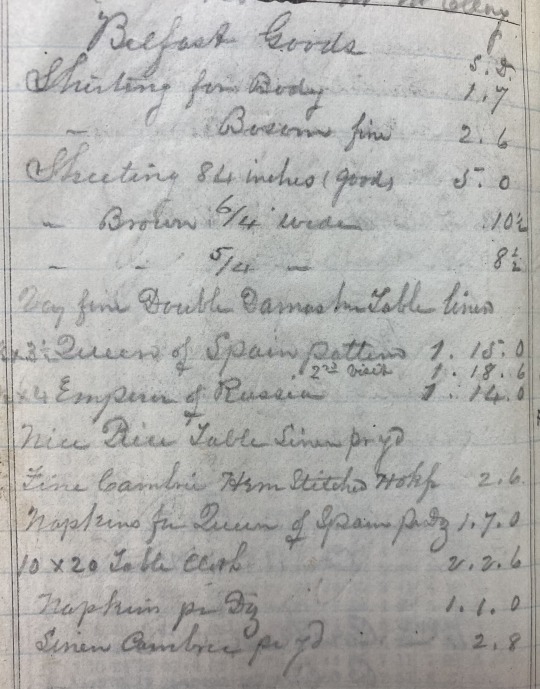
(Above) A list of goods and their prices that Chess took note of in Belfast, from “European Travel Diary, April 2, 1867 - August 25, 1867,” Moses Chess Diaries and Papers, AIS.2021.04, Archives & Special Collections, University of Pittsburgh Library System.
Chess stayed for a few weeks in Paris during the Exposition Universelle of 1867, the second world’s fair in the city. The international character of the event inspired some reflection on Chess’s part, writing on June 14th: “One peculiarity I sensed was that each nation (except perhaps Americans) admired the productions of their own country more than that of any other.” In an earlier entry, on June 12th, he complains of the lack of English speakers in Paris and the high prices charged at restaurants, sounding not too different from a modern-day tourist.
1867 wasn’t the only time Chess recorded his travels. In 1855, he took multiple trips sailing the Ohio and Mississippi Rivers, transporting freight. These trips would often culminate in Chess staying in New Orleans for a couple days, where he’d record some observations. On January 19th of 1855, during one of these stays in New Orleans, he notes attending a slave auction and minstrel show: brief reminders of the racist society he was operating within.
While much of Chess's diary during these sailing trips represents his typical attention to work and business—mostly dedicated to noting how adventitious sailing conditions are and when and where he’s discharging freight—his diary also has brief moments that indicate some of the real risks involved in such mercantile undertakings at the time. In a series of entries from May 24th to the 26th he notes burying many people due to a cholera outbreak. At the end of the diary for that year, in the “Memorandum” section, he would write down the directions for a cholera treatment.
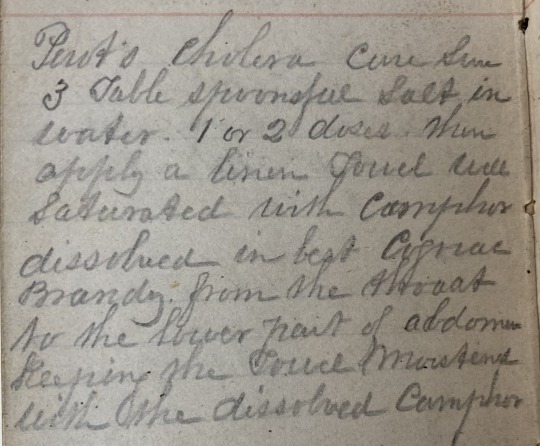
(Above) A treatment for cholera, from “Daily Diary, 1855,” Moses Chess Diaries and Papers, AIS.2021.04, Archives & Special Collections, University of Pittsburgh Library System.
His diaries over the years contain many similar recipes and directions for medical treatments, for such things as diarrhea, smallpox, and diphtheria. These could be valuable evidence for popular medical treatments in the U.S. in the latter half of the 19th century—but they also give hints of the more human vulnerabilities and struggles lying behind these otherwise routine diaries.

(Above) A treatment for smallpox, from “Daily Diary, 1883,” Moses Chess Diaries and Papers, AIS.2021.04, Archives & Special Collections, University of Pittsburgh Library System.
Evidence of illness can appear in other ways as well. One of the unexpected interests of these diaries for me has been when Chess wasn’t writing any entries—sometimes for over a month, although only rarely. These incidents often seem to represent a period of illness. For instance, his diary for 1889 suddenly ends early on December 11, with next year’s diary only picking back up on January 27th with Chess noting a doctor had advised him “to make a trip south as soon as possible.” Chess didn’t seem to heed this advice, continuing with his business—and writing 6 more years’ worth of diaries in the process. In 1895, however, the gaps in entries became larger again, with his final entry being written on November 20th. In it, he notes that someone visited in the afternoon: “No business transacted as I remember.”
These diaries can be a valuable primary source for researchers interested in these topics, offering a wealth of daily information and some unique observations. They can be found in the Moses Chess Diaries and Papers collection, which is housed and available for researchers to access at the Archives & Special Collections at our Archives Service Center location on Thomas Boulevard.
Works Cited
Moses Chess Diaries and Papers, AIS.2021.04, Archives & Special Collections, University of Pittsburgh Library System.
9 notes
·
View notes
Text
40th Anniversary of the 1982 Sugar Bowl
This post was written by Jon Klosinski, Archives Assistant for Archives & Special Collections.
January 1, 2022, marks the 40th Anniversary of Panther Football's victory in the 1982 Sugar Bowl game. Led by Coach Jackie Sherrill and Quarterback and future College and Pro Football Hall of Famer Dan Marino, the #8 ranked Panthers defeated the #2 ranked Georgia Bulldogs (both with 10-1 season records) 24-20 in New Orleans Louisiana before a nationally televised audience.
The game will be remembered forever for its dramatic finish. On 4th down and down 3 points with 42 seconds remaining in the game, Marino completed a game winning touchdown pass to tight end John Brown in what is among the greatest moments in college sports history:
youtube
Video courtesy of University of Pittsburgh on YouTube.
The Sugar Bowl victory completed a dominant three year run which saw Panther Football achieve a combined record of 33 wins and 3 losses with victories in three straight College Football bowl games, one of the longest sustained runs of success in Pitt Football history. The 1981 Panther Team also included three 1982 NFL draftees- Center Emil Boures, Linebacker Sal Sunseri and Defensive End Sam Clancy. Coach Sherrill, after a 6-season tenure at Pitt achieved a 50-9-1 record. Marino departed Pitt for the NFL after the 1982 season, having led the Panthers to four consecutive Top Ten AP Poll finishes and four total bowl game appearances. His #13 jersey was retired by Pitt in 1982.
The Archives & Special Collections Department of the University of Pittsburgh Library System is proud to share artifacts in our collections from that historic Sugar Bowl game and 1981-82 Football season:
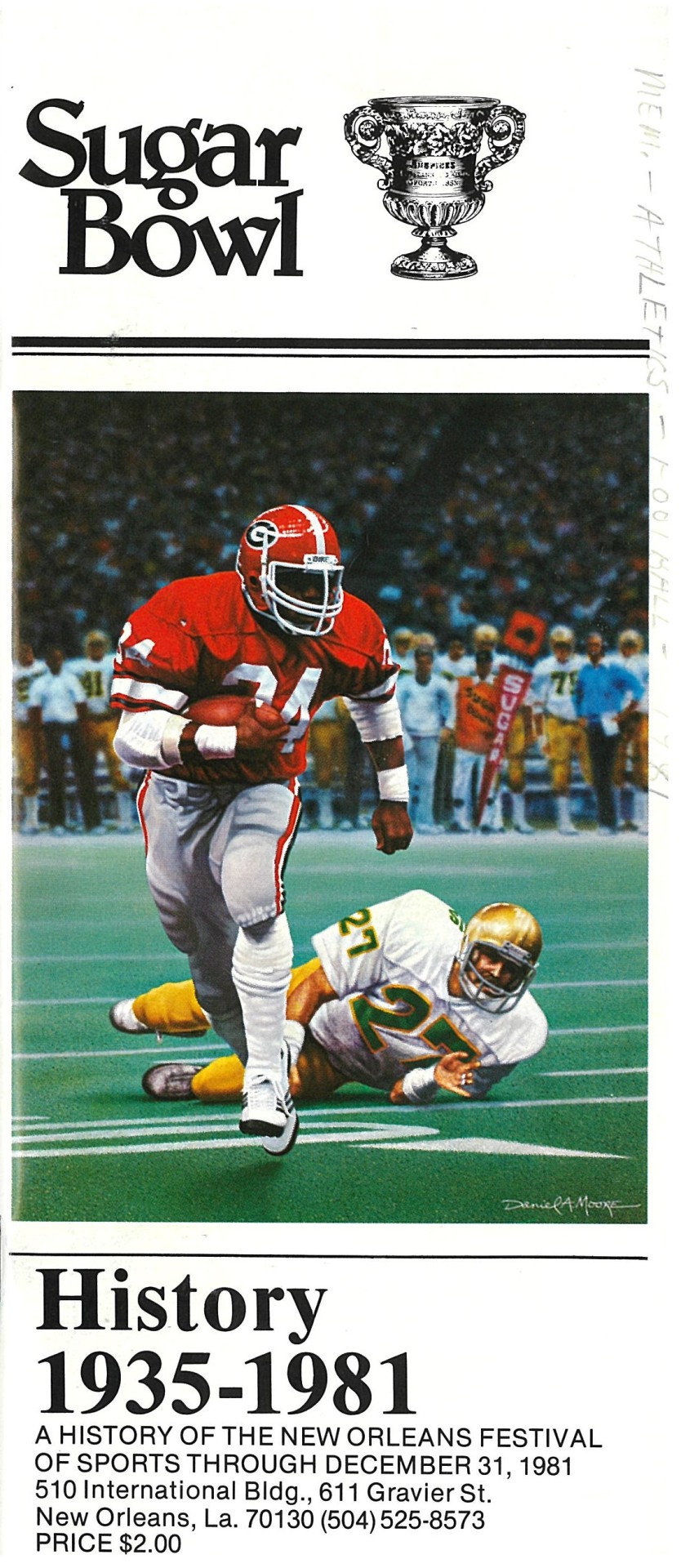
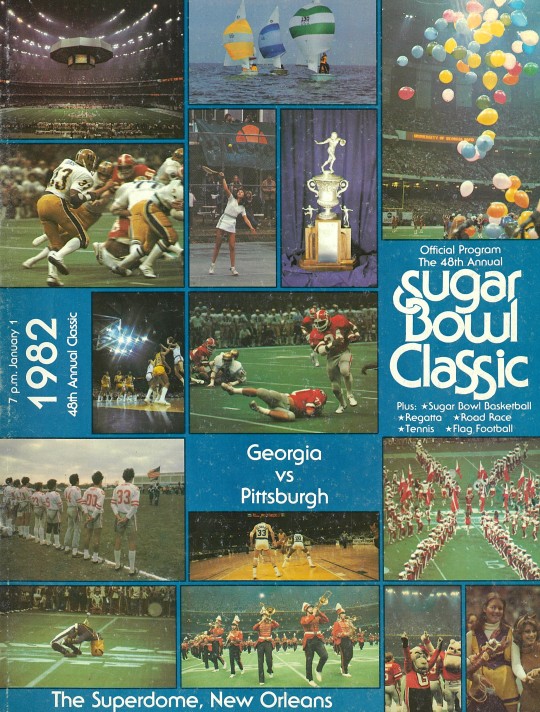
(Above) Official Sugar Bowl 1982 Game Program and Media Guide University Archives Record Group 9/10-A Athletics-Football. Box 4 FF 16. Archives and Special Collections, University of Pittsburgh Library System.
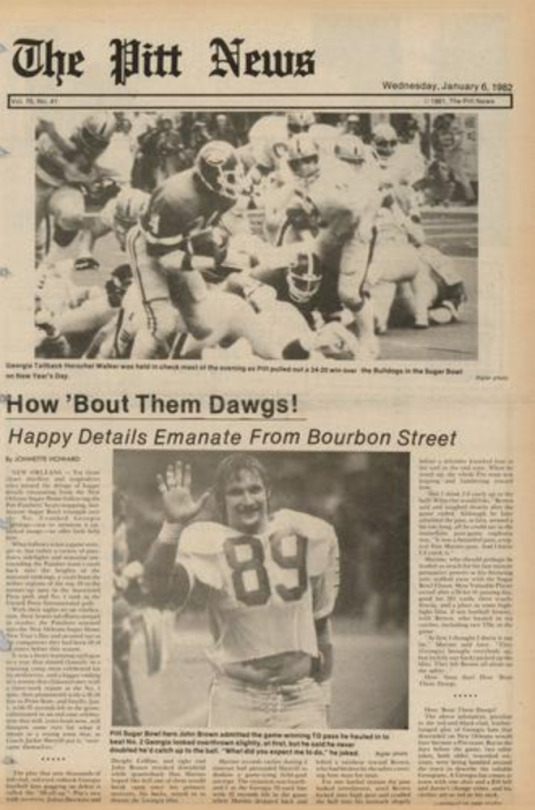
(Above) The Pitt News from January 6, 1982, celebrating Panther victory in the Sugar Bowl. Full issues of the Pitt News are available on the Archives and Special Collections Documenting Pitt Website. Pitt News, Vol. 76 No. 41, Archives and Special Collections, University of Pittsburgh Library System.

(Above) Dan Marino and Coach Jackie Sherrill, c. 1981. On 4th down with 42 seconds left in the game, Marino famously told Coach Sherrill he didn't come all the way to New Orleans to tie the game. University of Pittsburgh Historic Photographs. FTBL05.UA. Archives and Special Collections, University of Pittsburgh Library System.
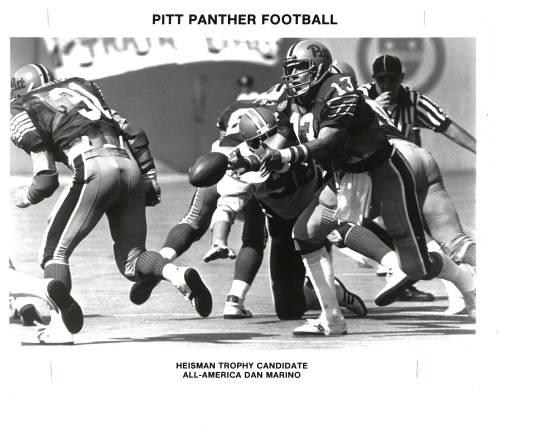
(Above) Marino was a 4th place finalist in Heisman Trophy voting for the 1981 season, receiving a total of 286 votes. He was opposed at the Sugar Bowl by 2nd place finisher, Georgia Running Back Herschel Walker (who would win the honor the following season). University Archives Personal File: Marino, Dan. Archives and Special Collections, University of Pittsburgh Library System.
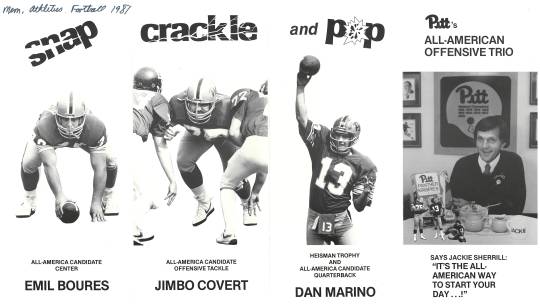
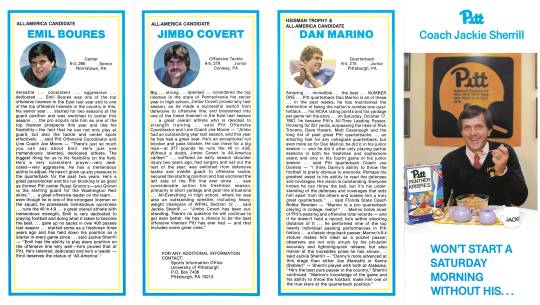
(Above) Coach Jackie Sherrill never started a pre-game Saturday morning without his "Snap, Crackle and Pop." University Archives Record Group 9/10-A Athletics-Football. Box 4 FF 16. Archives and Special Collections, University of Pittsburgh Library System.



(Above) The 1982 Panther Prints yearbook displays a photo collage of the student trek to the 1982 Sugar Bowl in New Orleans, Louisiana. Pitt yearbooks are available online through the Documenting Pitt website. Panther Prints 1982. Archives and Special Collections, University of Pittsburgh Library System.
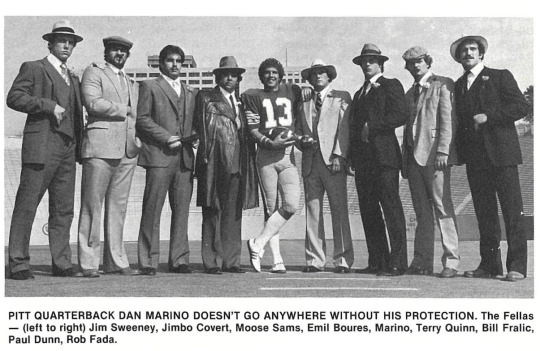
(Above) Marino never went anywhere during the 1981 season without his "protection". Official Football Publications. Pitt qLH1.P69V3.1981 Archives and Special Collections, University of Pittsburgh Library System.
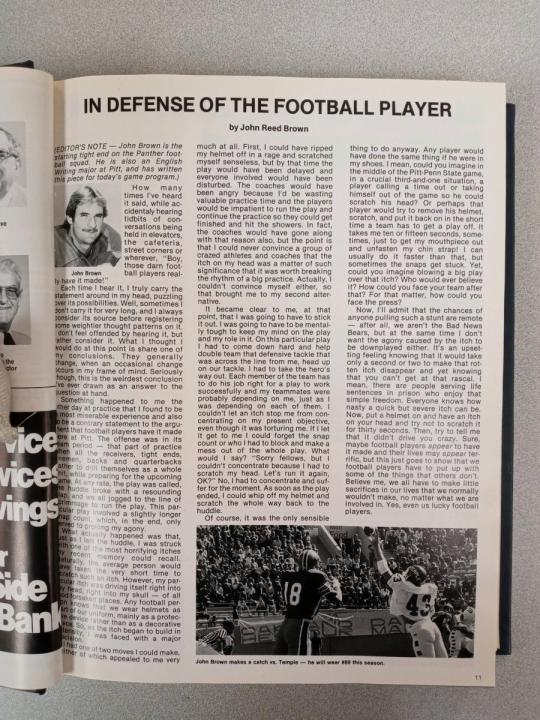
(Above) John Brown, Starting Tight End and English Writing major composed original essays for inclusion in Panther gameday programs during the 1981 season. Official Football Publications. Pitt qLH1.P69V3.1981 Archives and Special Collections, University of Pittsburgh Library System.
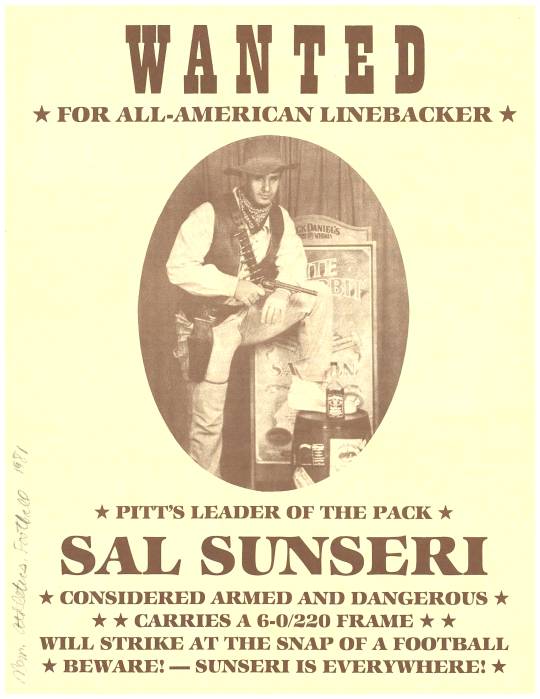

(Above) "Wanted "for NCAA All-American recognition in 1981: Pitt Linebacker Sal Sunseri (He received the honor) University Archives Record Group 9/10-A Athletics-Football. Box 4 FF 16. Archives and Special Collections, University of Pittsburgh Library System.

(Above) Pitt Football bumper stickers from the 1981 season. University Archives Record Group 9/10-A Athletics-Football. Box 4 FF 16. Archives and Special Collections, University of Pittsburgh Library System.
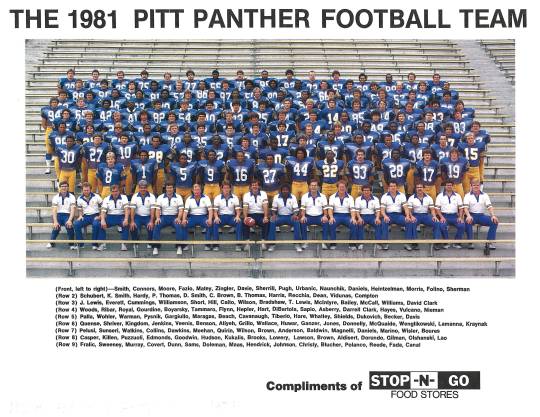
(Above) The 1981-82 Pittsburgh Panthers Football Team. University Archives Record Group 9/10-A Athletics-Football. Box 4 FF 16. Archives and Special Collections, University of Pittsburgh Library System.
9 notes
·
View notes
Text
Jacob Bates Abbott and the United States Wilderness
This post was written by Meara “Yara” Makasakit, (Fall 2021 Undergraduate Intern)
Though environmental conservation awareness seems like a relatively new historical phenomena, the idea of protecting wildlife has existed for thousands of years. Many Indigenous cultures have held the natural world up with great respect. One of the Tlingit Tribe of Alaska’s core beliefs is to “build on the foundation of respect for... the bounty of the land and waters, and the land itself.” In contrast, the United States government began the crusade for conservation during the presidency of Theodore Roosevelt and continues to make environmental legislation to this day.
The early 1900s proved to be an exciting and tension-filled time for European-descended conservationists in the United States. At this time, conservationists sought to protect the great wonders of the United States from being exploited due to a lack of land regulation after the removal of Native Americans and transfer of their land to the United States government. People like Theodore Roosevelt, John Muir, and George Bird Grinnell fought for the protection of these lands and the wildlife it was home to. Through these efforts, the American public was able to learn and find avenues for themselves as individuals to take a stance and speak out. One artist who dedicated an entire career and body of work to the cause Jacob Bates Abbott. Abbott was an American artist whose work focused on US wildlife and had a career in creating art for publication in magazines and books.
In the Jacob Bates Abbott Papers at the University of Pittsburgh Library System Archives & Special Collections, which I processed this semester, you can see evidence that Abbott had a longstanding relationship with the Pennsylvania Game News magazine. This was a hunting publication with a heavy focus on conservation and safe hunting practices. Abbott created the covers for the magazine’s monthly publications for almost ten years and wrote several articles for the magazine. The themes of these covers typically followed the holiday or season for that month, but always depicted a scene from nature.
In his June 1947 cover, Abbott illustrated a scene of a family of ducks wading in a stream with a curious deer beside them. In this work, and others, it can be inferred that Abbott did not actually witness this exact scene while out observing nature, but the skill and detail he includes gives the work life-like qualities. Though Abbott’s paintings were not hyper-realistic, the nature observations that he was constantly conducting shows in the detail of his work: the physical anatomy of the creatures, color patterns of the different animal’s fur and feathers, reflections in the water, and the surrounding greenery.
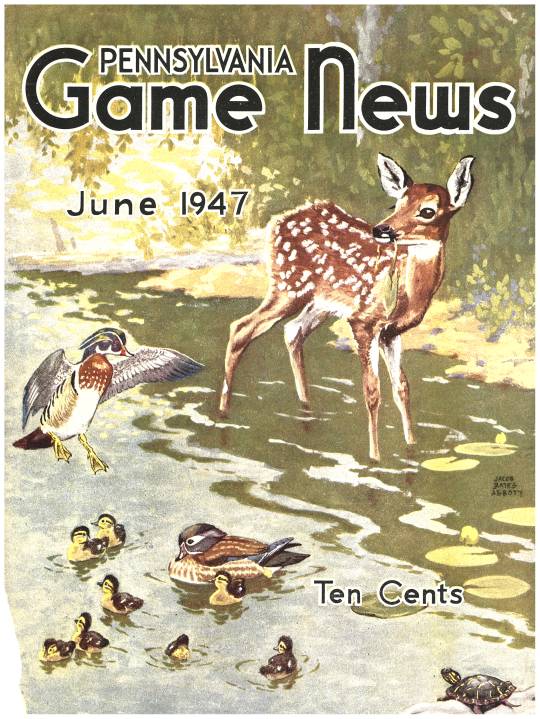
(Above) Image from folder “Pennsylvania Game News,” Jacob Bates Abbott Papers, AIS.2018.03, Box 12, Folder 8, Archives and Special Collections, University of Pittsburgh Library System. Pennsylvania Game News cover from July 1947 depicting a family of ducks wading in a stream accompanied by a deer.
He was able to accomplish this by carrying out his own research and studies of the natural world. Abbott’s field notes are filled with his sketches and notes of what he had seen in places such as Pennsylvania, California, New Hampshire, and more. Abbott was dedicated to observing the world as it was, spending a great deal of time in the Pennsylvania wilderness watching and taking note of everything and anything he came across. It is incredibly apparent that Abbott cared a great deal for the work he was doing and found it to be important enough to commit most of his life and career to.
It was through observations that Abbott was able to re-imagine nature and its inhabitants to fit the themes of his covers. His re-interpretations of nature were, at times, more direct than the June 1947 magazine. In a cover he created for This Week Magazine: Portland, Oregon, Abbott illustrates a humorous scene of two puppies floating on a piece of wood, scared of an approaching turtle. This obviously is not a realistic scene, but it demonstrates how Abbott was able to adjust his style depending on the subject matter of his work.
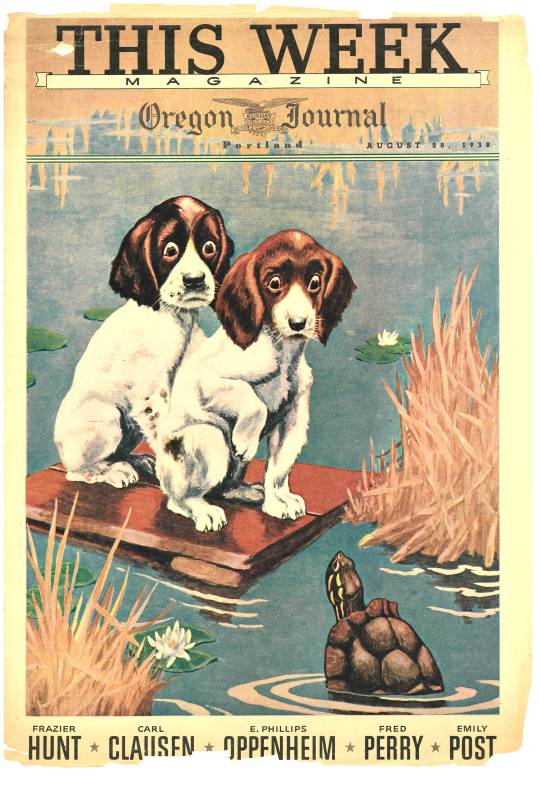
(Above) Image from folder “This Week Magazine, Oregon Journal,” Jacob Bates Abbott Papers, AIS.2018.03, Box 14, Folder 19, Archives and Special Collections, University of Pittsburgh Library System.
This Week Magazine Cover from August 28, 1938, depicting two puppies being frightened by an approaching turtle.
Many of Abbott’s most known publication cover designs were originally paintings. He was incredibly skilled in other mediums such as ink and graphite. Abbott’s cartoons and ink drawings can be found in most issues of the Pennsylvania Game News magazines that he also created covers for. Here, he provided illustrations and cartoons for articles that were being published, usually of the different species that are being discussed in the writing. Building on these simple drawings, he created covers for the Yankee magazine that were detailed line drawings. Though he was not as prominent of a figure at the Yankee as he was at the Pennsylvania Game News, the same principles of observation applied for the work he did there.
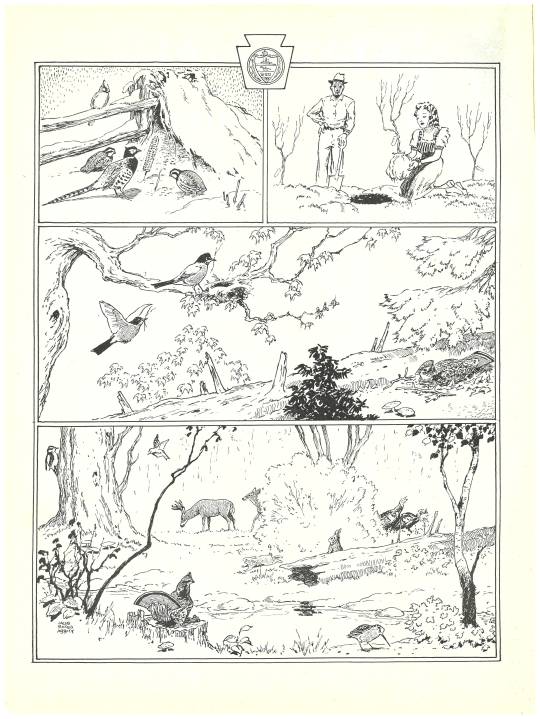
(Above) Image from folder “Pennsylvania Game News,” Jacob Bates Abbott Papers, AIS.2018.03, Box 11, Folder 3, Archives and Special Collections, University of Pittsburgh Library System. Pennsylvania Game News magazine, March 1945, page sectioned into 4 parts depicting different scenes of wildlife and one with a Pennsylvania trooper and woman planting a tree.
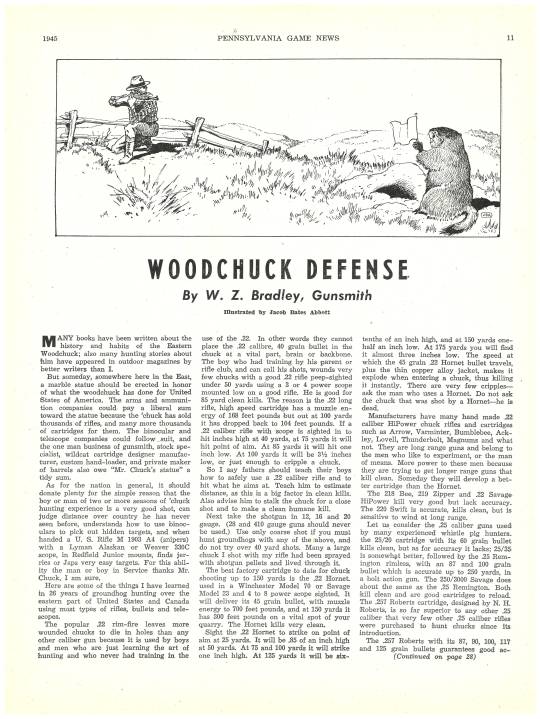
(Above) Image from folder “Pennsylvania Game News,” Jacob Bates Abbott Papers, AIS.2018.03, Box 11, Folder 3, Archives and Special Collections, University of Pittsburgh Library System. Pennsylvania Game News magazine, March 1945, article, “Woodchuck Defense,” illustration of a hunter and woodchuck holding a flag of surrender.
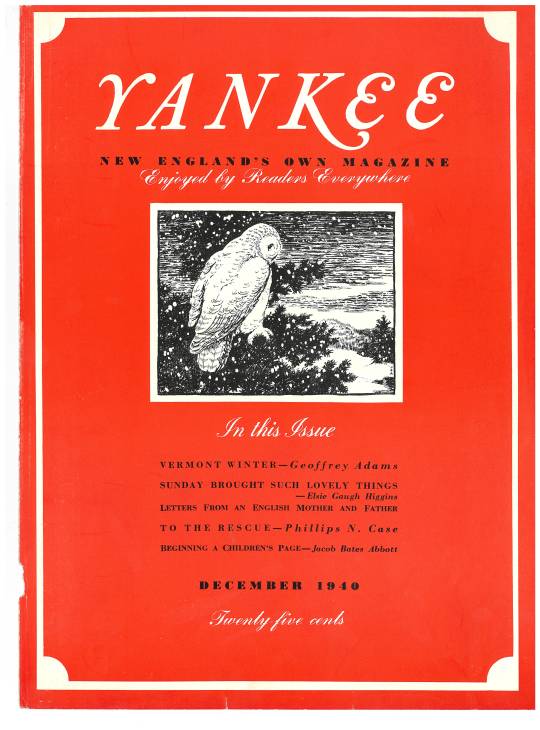
(Above) Image from folder “Yankee,” Jacob Bates Abbott Papers, AIS.2018.03, Box 12, Folder 13, Archives and Special Collections, University of Pittsburgh Library System. Yankee magazine cover from December 1940 depicting an owl standing on a tree branch during a winter snowfall.
Though Abbott has not been well-documented historically, the entirety of his artistic career is now housed in his papers at the University of Pittsburgh Library System Archives & Special Collections, which includes most of his original work. This collection is important because it shows the ongoing history of the fight for conservation, particularly on the side of conservation awareness. Abbott was able to bring the United States wilderness to people’s homes, offices, and schools. This allowed the entire country, particularly Pennsylvanians, to see the beauty of nature and to garner support for its care. The natural world continues to need people to defend, protect, and speak up for it. From the earliest Indigenous people, to politicians, to private business, and now to the individual, conservation is still a present-day concern that cannot be given up.
Citations:
“About Us.” Tlingit & Haida - About Us - Overview, http://www.ccthita.org/about/overview/index.html.
Burns, Ken, director. The National Parks: America's Best Idea, The Last Refuge: 1890-1915, Public Broadcasting Service, n.d..
“Conservation Timeline 1901-2000.” National Parks Service, U.S. Department of the Interior, 26 Feb. 2015, https://www.nps.gov/mabi/learn/historyculture/conservation-timeline-1901-2000.htm.
Jacob Bates Abbott Papers, AIS.2018.03, Archives & Special Collections, University of Pittsburgh Library System.
4 notes
·
View notes
Text
The Pittsburgh Musicians’ Union Merger: “It Revolves Around Representation”
This post was written by Char Pyle (Fall 2021 Undergraduate Intern).


(Above) Pages from the program of the AFM’s 1962 Annual Convention, hosted at the Civic Arena in Pittsburgh. American Federation of Musicians, Local 60-471, Pittsburgh, Pa. Records, 1906-1996, AIS.1997.41, Archives & Special Collections, University of Pittsburgh Library System.
The American Federation of Musicians (AFM) is a labor union representing musicians across the country. The Pittsburgh Musicians’ Union, Local 60-471 of the AFM, has a particularly storied history. Local 60 was formed in 1897, one year after the AFM was founded. In 1908, Local 471 was created for black musicians in Pittsburgh. The two locals merged in 1966 following an integration order from the AFM. While the integration seems like it could be a positive thing, this only meant it would be more difficult for black musicians to advocate for themselves and be heard. This is evident even in the meeting minutes between both locals surrounding the merger. This interaction is noted at the beginning of the meeting:
“Before considering items, Pres. Davis asks: ‘How can we meet on common ground? What do we need? (to effect agreeable merger)’ Pres. Westray answers: ‘It revolves around representation.’”
This emphasis on representation is visible in Local 471’s proposals during the merger. Policies proposed by Local 471 included suggestions of affirmative action, shown in “Exhibit D” under “Negro Representation in Elective Offices of the Merged Union”. They sought out guaranteed representation in elected office, as they were likely not hopeful that they would truly be perceived as equals by the majority-white membership base of the merged union. Unfortunately, this has proved to be true. Since the merger, and still today, leadership of Local 60-471 is primarily white. Based on these minutes, it appears these suggestions were heavily contested and subsequently dismissed by members of Local 60. One of their arguments was that this was “a type of segregation in reverse”. This shouldn’t be an unfamiliar idea, as similar arguments are still echoed today in the realms of employment and education.

(Above) Exhibit D in the merger meeting minutes between the executive boards of both locals. American Federation of Musicians, Local 60-471, Pittsburgh, Pa. Records, 1906-1996, AIS.1997.41, Archives & Special Collections, University of Pittsburgh Library System.
Another result of the merger is the lack of records from Local 471. There is significantly more material available for Local 60, including film reels, publications, meeting minutes, photographs, and various booklets. It’s not clear why this discrepancy exists, but Local 471’s records may have simply been overshadowed as the merged union was mostly made up of former Local 60 members. This could have led to the merged local being viewed as simply a continuation of the white local, devaluing the preservation of artifacts related to Local 471. The merger also caused many black members to become disillusioned with the union, so there wouldn’t have been many people interested in preserving those records anyway. The effects of this lack of preservation were apparent almost immediately, as membership cards for many Local 471 members were lost in the merger. This led to a discontinuation of seniority benefits (even though the opposite was promised in the merger minutes), which caused many to cancel their memberships.
It’s difficult to say whether much would have changed had these policies been approved. Perhaps with more of a presence in the administration of the union, Local 471 would have retained more of its membership and its history would have been better preserved. When so many former Local 471 members resigned, they lost the ability to play music in Pittsburgh. The city may have missed out on countless performances and talented artists because of this. Unfortunate as it may be, this event was a milestone for black musicians in Pittsburgh, and greatly shaped the landscape of Pittsburgh music as a whole. This collection would be of use to those researching local musicians from the 20th century. Prominent figures that were members of Local 471 include the following, and membership cards are available for each:
Carl Arter (President)
George Benson
Art Blakey
Ray Brown
Roy Eldridge
Erroll and Linton Garner
Walter Harper
Joe Harris
Earl Hines
Roger Humphries
Ahmad Jamal
Grover Mitchell
Horace Parlan
Stanley Turrentine
Joe Westray (President at time of merger)
Mary Lou Williams
Ruby Younge Hardy (Secretary-Treasurer)
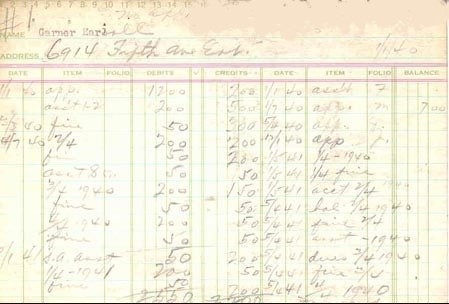

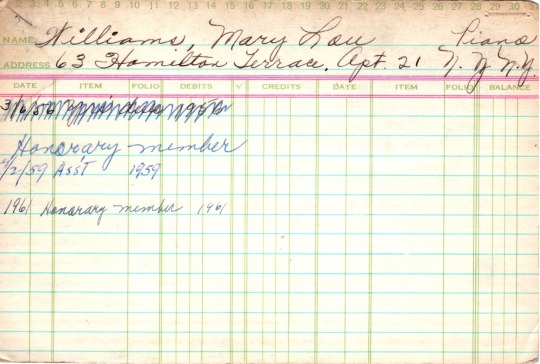
(Above) Membership cards (from top to bottom) of Art Blakey, Erroll Garner, and Mary Lou Williams. American Federation of Musicians, Local 60-471, Pittsburgh, Pa. Records, 1906-1996, AIS.1997.41, Archives & Special Collections, University of Pittsburgh Library System.
Additional Sources:
http://jazzburgher.ning.com/profiles/blogs/old-mon-music-pittsburgh-blog
https://www.afm.org/about/history/
https://www.afmpittsburgh.com/a01-aboutus.html
http://exhibit.library.pitt.edu/labor_legacy/MusiciansHistory471.htm
American Federation of Musicians, Local 60-471, Pittsburgh, Pa. Records, 1906-1996, AIS.1997.41, Archives & Special Collections, University of Pittsburgh Library System
2 notes
·
View notes
Text
"Another Level of Consciousness": Black Excellence in Theatre
This post was written by Sean Hale, Undergraduate student of Theatre Arts and Linguistics and student assistant on the CLIR Recordings at Risk grant “Preservation and Access to Pittsburgh’s Black Arts Movement Performance Organizations: The Legacy Media of the Bob Johnson Papers and Kuntu Repertory Theatre Collection”.
The University of Pittsburgh Archives & Special Collections is home to a wide array of artifacts, sources, and stories just waiting to be explored. Over the summer, I have been reviewing and creating descriptive metadata for VHS and U-Matic tapes from the Kuntu Repertory Theatre Collection and Bob Johnson Papers for digitization. During my time here, I was able to view and closely study the works of the Kuntu Repertory Theatre (KRT) and their contributions to the black community. A theatre group that had a timeless and vital message that not only swayed Pittsburgh, but reached national notoriety.
KRT was able to host a number of outstanding and provocative stage pieces. One such event was the phenomenal performance of Lorraine Hansberry's "A Raisin in the Sun" for its 25th anniversary. This production was truly an event to be seen, with special guest Esther Rolle (known for her role as "Florida Evans" in the television show Maude) in the roll of Lena Younger. It can be seen to what extent KRT planned and crafted the telling of this story to their audience.
No small detail was left untouched, ranging from the performers' careful voice and movement, to the fine characteristics and formation of the set. The action of the play revolves around a two-bedroom apartment in Chicago's Southside. The design for stage was a captivating construction that took what should have been imagined as a three-dimensional home and splayed it out in a two-dimensional view. The choice outlined the run-down, dull, and flat feeling of the apartment and illustrated the struggle of the characters feeling trapped in their space.

(Above) Marcia Jones, in the role of Ruth Younger, and Esther Rolle, in the role of Lena Younger, performed by Kuntu Repertory Theatre in Stephen Foster Memorial Hall, 1984.
The recording, seemingly professionally shot, was able to capture close-up imagery of the performers, highlighting the delicate work and dedication they invested into portraying such dynamic characters. Marcia Jones, in the role of Ruth Younger, demonstrated a noticeably exhausted and worn figure in her portrayal through her tone and posture. She also carried an exceptional energy that she passed back and forth in scenes with Walter Lee, played by Donus Crawford. Rolle's depiction of Lena was also truly exceptional, with the tape perfectly capturing her tight and rigid body that was held with teary eyes and a shaky voice during the scene following Walter Lee's heartbreaking mistake.

(Above) Donus Crawford, in the role of Walter Lee Younger.
Kuntu Repertory Theatre was grounded in two important ideals. In terms of mission, they ensured that black artists and technicians could tell the stories that often went overlooked, highlighting the black experience by a black arts collective. In terms of art, they created spaces and performances that emphasized the experience of art, rather than the object of art itself. KRT found its roots for these objectives in the Black Arts Movement and the artistic traditions that were embedded in African culture and its continuum. This piece exquisitely underlined this goal with grand detail, even so much that the program used for this production was only slightly edited from the original premiere in 1959.
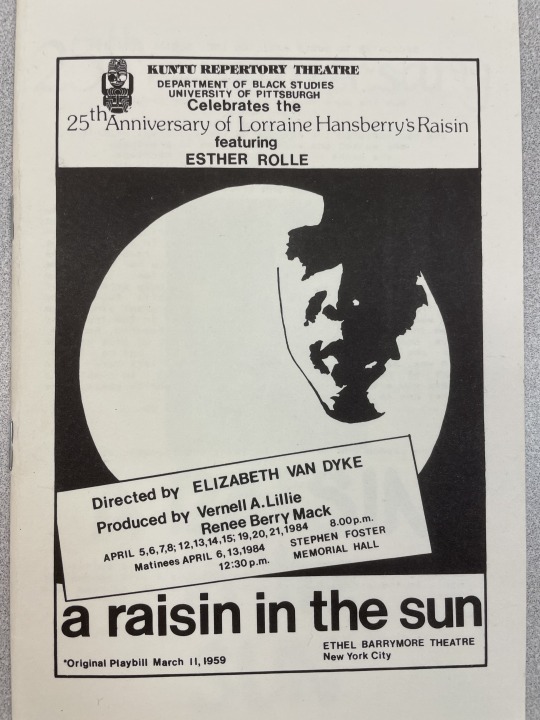
(Above) Kuntu Repertory Theatre’s program for its production of A Raisin in the Sun, April 1984.
The combination of performance, design, and overall elements of production detailed the struggle that black people in America have experienced for generations. Kuntu Repertory Theatre's production of "A Raisin in the Sun" exemplifies the story's undying message, whether that be 1959, 1984, or even today.
#blacktheatre#blackart#black#theatre#art#civilrightsmovment#araisininthesun#lorrainehansberry#kunturepertorytheatre
0 notes
Text
Dick Thornburgh: An Inspection of Politicians’ Core Beliefs across their Careers
The post was written by Caleb Tsai, an Undergraduate Computer Science major at the University of Pittsburgh and a student in the Honors College’s Foundations of Research and Scholarship course in the Spring of 2021
Dick Thornburgh was an extremely influential figure in both the United States and the greater Pittsburgh region, serving as U.S. Attorney for the Western District of Pennsylvania, Governor of Pennsylvania, and U.S. Attorney General. In 1998, the Dick Thornburgh Papers, the archive upon which this research is founded, was donated to the University of Pittsburgh Library System. I chose to research Dick Thornburgh because I was intrigued by both the depth and breadth of Thornburgh’s actions throughout his career. Initially, I did not know what specific areas I wanted to delve into, but the Thornburgh Papers provided an abundance of resources to aid me during my search.

Figure 1 (above): Formal picture of Dick and Ginny Thornburgh with their four sons, 1972. Dick Thornburgh Papers, Series XVIII. Photographs, 1932-2004. Dick Thornburgh Papers, 1932- , AIS.1998.30, Archives & Special Collections, University of Pittsburgh Library System.
My motivation for this proposal is mainly due to an interest in whether political figures are trustworthy in following through on their campaign agendas prior to being elected. At the time of this publication, the 2020 Presidential election between incumbent Republican Donald Trump and Democrat Joe Biden has recently concluded, and I want to learn more about whether ideas and beliefs held by political figures change or remain consistent over the entirety of their careers.
Thus, my research question is defined as follows:
As Attorney General of the United States, how was Dick Thornburgh’s focus on criminal justice and environmental reform tied to his preceding title of Governor of Pennsylvania?
I felt that this initial question could then introduce a larger problem statement:
Discover trends across two ends of Thornburgh's political career to identify continuity and change regarding criminal and environmental reform.
Finally, I constructed my significant statement, which can be tied back to my initial interests in Dick Thornburgh and his career:
Uncover insight into the inner workings of prominent political figures and how their ideas developed throughout their career.
In terms of archival material, I concluded that Thornburgh remained most aligned with issues regarding criminal reform during his role as both Governor of Pennsylvania from 1978-1987 and Attorney General of the United States from 1988-1991. In September 1978, his first year as governor, Thornburgh published an “Outlined 7-point plan for "cleaning up" corruption in PA's General Assembly, Harrisburg, PA.” I identified from Thornburgh’s direct quotes (Figure 2) that he utilized very confident and passionate language in describing the sheer frequency and need to reduce corruptions within government: ‘I know how to get rid of corruption because I’ve done it… The only way to clean up Harrisburg is to clean it out. And the effort has to start at the very top.’ In terms of context, it is also important to note that this news release was published by Thornburgh and his running mate William Scranton for their campaign, which explains why Thornburgh is portrayed in this manner.
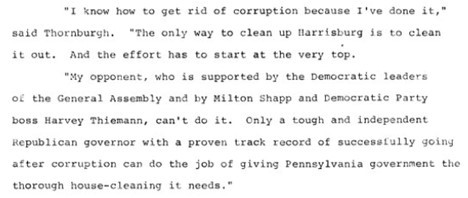
Figure 2 (above): Outlined 7-point plan for "cleaning up" corruption in PA's General Assembly, Harrisburg, PA, 1978. Dick Thornburgh Papers, Series IX. Campaign for Governor of Pennsylvania, 1978. Dick Thornburgh Papers, 1932-, AIS.1998.30, Archives & Special Collections, University of Pittsburgh Library System.
Later in Thornburgh’s career as Attorney General of the United States, I found that a very similar sentiment in combating corruption remained at the forefront of Thornburgh’s mind in his “Statement Before the Committee on Banking, Housing, and Urban Affairs Concerning Fraud in the Savings and Loan Association Area” in February 1989. From the initial paragraphs of this document (Figure 3), one can tell that Thornburgh maintains his strict stance against corruption regardless of the institution, the party in question now a financial rather than government body. In a position of greater influence, Thornburgh then effectively uses his power by addressing and insisting the Committee on Banking, Housing, and Urban Affairs take action, conveying Thornburgh’s genuine desire to combat the same corruptions he addressed early in his political career.
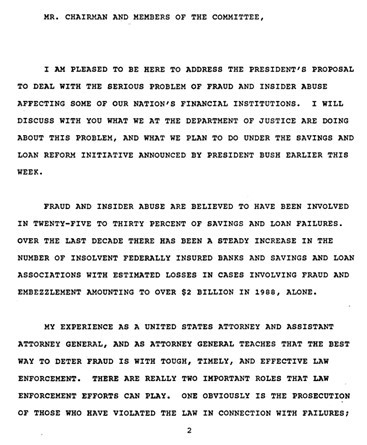
Figure 3 (above): Statement Before the Committee on Banking, Housing, and Urban Affairs Concerning Fraud in the Savings and Loan Association Area, 1989. From the U.S. Department of Justice. Dick Thornburgh Papers, 1932-, AIS.1998.30, Archives & Special Collections, University of Pittsburgh Library System.
Thus, Dick Thornburgh did in fact represent continuity in his vision for reforming the corruption that readily existed at the beginning of his career, the end of his career, and still exists in the present. However, one must understand that not every political figure may be as forthcoming or stay true to their initial agendas. To reinforce the results of this study, the next steps moving forward will be to examine political figures from a vast array of backgrounds and political systems. In this manner, incorporating a wide range of diverse variables will lead to stronger and more reliable results. Ultimately, we will then continue to uncover more and further appreciate these gifted men and women in our history who have and continue to pave the institutions we view as places of authority and influence.
Works Cited
Unknown Photographer. “Formal picture of Dick and Ginny Thornburgh with their four sons”, 1972. University of Pittsburgh, Dick Thornburgh Papers, Series XVIII. Photographs, 1932-2004. Dick Thornburgh Papers, 1932-, AIS.1998.30, Archives & Special Collections, University of Pittsburgh Library System.
Press Release. “Outlined 7-point plan for "cleaning up" corruption in PA's General Assembly, Harrisburg, PA,” 1978. University of Pittsburgh, Dick Thornburgh Papers, Series IX. Campaign for Governor of Pennsylvania, 1978. Dick Thornburgh Papers, 1932-, AIS.1998.30, Archives & Special Collections, University of Pittsburgh Library System.
Thornburgh, Dick. “Statement Before the Committee on Banking, Housing, and Urban Affairs Concerning Fraud in the Savings and Loan Association Area,” 1989. From the U.S. Department of Justice. Dick Thornburgh Papers, 1932-, AIS.1998.30, Archives & Special Collections, University of Pittsburgh Library System.
1 note
·
View note
Text
John Hammond and Martha Glaser: A Cold Correspondence
This post was written by Adam Lee, graduate student, Jazz Studies.
Erroll Garner famously won a lawsuit against record production titan Columbia Records in the early 1960s, which allowed him to launch his own label Octave records. While the details of this lawsuit have been covered by news outlets such as Variety (The True Story of Erroll Garner, the First Artist to Sue a Major Label and Win), the fallout of this suit would continue to echo throughout history in the form of a feud between Garner’s manager Martha Glaser and Columbia Records producer John Hammond.
John Hammond was a scion of the Vanderbilt family through his mother and by the 1930s had become one of the most influential promoters and producers of jazz, acting as a patron to such jazz legends as Count Basie, Billie Holiday, and Benny Goodman (who became his brother-in-law in 1942). He is often lauded for his staunch stance against racism through his promotion of jazz in a time in which it was considerably less common to find white people of status working to promote Black artists. Not all jazz artists would receive Hammond’s full support, however, as is made clear with his lukewarm response to Erroll Garner’s work.
Hammond was the producer working for Columbia when the events that led to Garner’s lawsuit came about, and later would become involved again in a Garner reissue project in 1975. Martha Glaser, writing on behalf of Garner, wrote to Hammond expressing her disdain for the way Columbia, and thus Hammond himself, was handling this project in the last few years of Garner’s life.
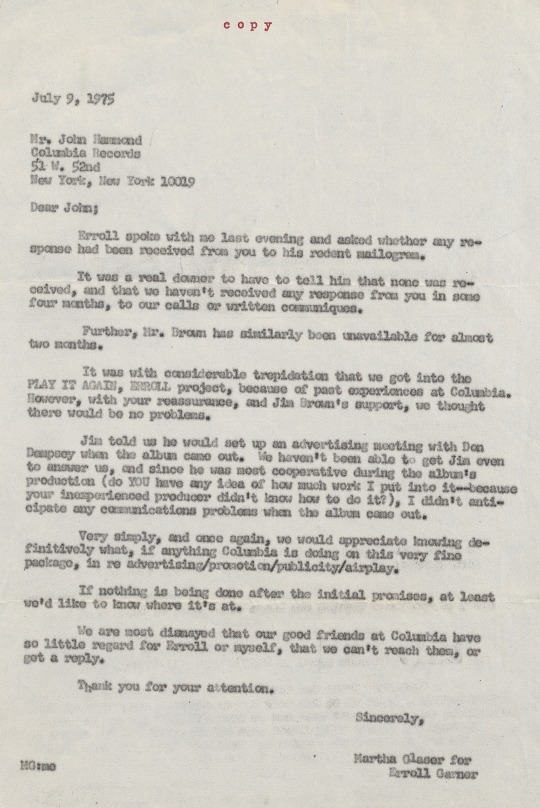
Image from folder “Correspondence from John Hammond,” Erroll Garner Archive, 1942-2010, Box 1, Folder 62, Archives & Special Collections, University of Pittsburgh Library System.
Glaser writes that Garner and she were reluctant to be involved in a Columbia production, understandable from their previous contentious relationship, but initially thought that Hammond would be supportive of the project: “It was with considerable trepidation that we got into the PLAY IT AGAIN, ERROLL project, because of past experiences at Columbia. However, with your reassurance, and Jim Brown’s support, we thought there would be no problems.” Clearly, there were problems and Glaser had no reservations expressing her feelings later in the letter writing: “We are most dismayed that our good friends at Columbia have so little regard for Erroll or myself, that we can’t reach them, or get a reply.” The venom in her language is clear, the Columbia producers are no friends of theirs.
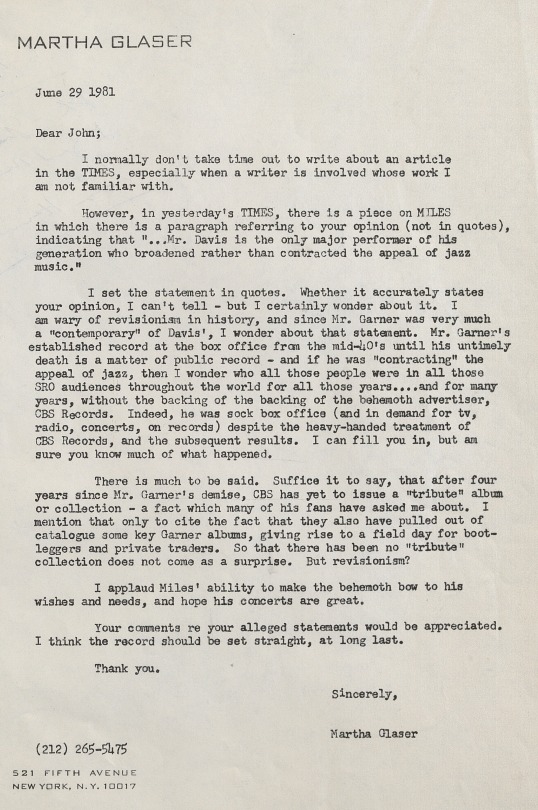
Image from folder “Correspondence from John Hammond,” Erroll Garner Archive, 1942-2010, Box 1, Folder 62, Archives & Special Collections, University of Pittsburgh Library System.
Several years later, after Garner’s passing, Glaser and Hammond got into another conflict via letters sent between them. We do not have every record in the archive of this correspondence, but by looking at the letters we do have we can extrapolate some of the content, and it is increasingly hostile. The conflict seems to begin with Glaser’s objection to a quote in George Goodman Jr.’s June 28, 1981 article about Miles Davis titled ”Miles Davis: I Just Pick Up My Horn And Play.” In the article, Goodman attributes a statement to Hammond (which Glaser notes is not written as a quote, but more as a statement of fact): “To John Hammond, the authoritative critic and jazz patron credited with the ‘discovery’ of such greats as Bessie Smith and Louis ''Satchmo'' Armstrong, Mr. Davis is the only major performer of his generation who broadened rather than contracted the appeal of jazz music.” Glaser vehemently objects to this characterization, and overtly questions Hammond on it in a letter dated the next day, June 29, 1981: “Whether it accurately states your opinion, I can’t tell – but I certainly wonder about it.” Glaser goes on to contradict the assertion that only Davis expanded jazz appeal, referring to Garner’s public success with scathing and sarcastic language: “… if he was ‘contracting’ the appeal of jazz, then I wonder who all those people were in all those SRO audiences through the world for all those years…,” and “Indeed, he was sock box office…despite the heavy-handed treatment of CBS Records, and the subsequent results. I can fill you in, but I am sure you know much of what happened.” Obviously Hammond knows what happened, as he was the head of A&R (Artists and Repertoire) for CBS/Columbia Records at that time.

Image from folder “Correspondence from John Hammond,” Erroll Garner Archive, 1942-2010, Box 1, Folder 62, Archives & Special Collections, University of Pittsburgh Library System.
Hammond’s response is dated July 16, 1981 and specifically refutes the Goodman article for the Times, attempting to redirect the ire against him to the Times itself saying, “Why the Times is so sloppy in its music coverage and quotes is beyond belief.” While he could have continued to play diplomat, he instead doubles down on the conflict and writes some very specifically cruel things about Garner and Glaser “…the greatest mistake he ever made was in leaving CBS for purely financial reasons. When I came back there in the very late fifties, I did my best to patch things up, but I must say that I found both you and Erroll greedy, to say the very least.” He follows this with an attack on Glaser alone: “Unfortunately, the nit-picking that went on by you (acting on behalf of Erroll) left you with very few friends in the company. When I tried to sign Erroll in the mid-sixties, I was warned that if I did, I would probably suffer another heart attack and was ordered to cease and desist my efforts.”

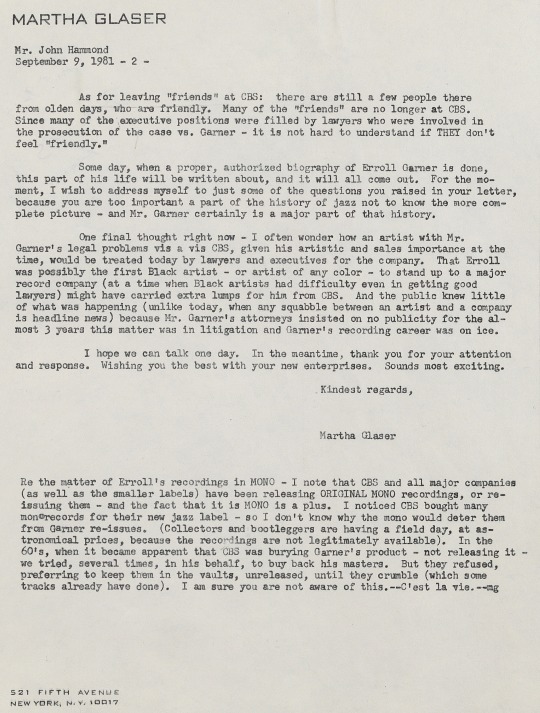
Images from folder “Correspondence from John Hammond,” Erroll Garner Archive, 1942-2010, Box 1, Folder 62, Archives & Special Collections, University of Pittsburgh Library System.
Glaser counters the attacks directly: “’Greed’ was not the reason for the litigation. It was at a great sacrifice – including a financial one – that Erroll was pressed into this litigation by some substantial violations of his contract.” Ever the stalwart defender of Garner, Glaser accuses Hammond of hiding this opinion from Garner behind a smiling face: “I wish you had told Erroll, at the time, or in the almost 20 years subsequent to the litigation, that you thought he and I were motivated by ‘greed’. This might have put a different face on how he reacted to the entire situation, and to you, since he always said – ‘Don’t put John in the middle’, and was concerned about your well-being.” Glaser continued to take issues with Hammond’s specific phrase “nit-picking,” and notes the implications of such language: “I sometimes wonder where such an appellation might be sexist. When a man works as hard and carefully as I have to maintain quality standards, he is considered to be on top of things.” The jarring final statement is loaded with a sarcastic feel, like Glaser is writing pleasantries because these things are included in letters by practice but not by meaning: “I hope we can talk one day. In the meantime, thank you for your attention and response. Wishing you the best with your new enterprises. Sounds most exciting.”

Image from folder “Correspondence from John Hammond,” Erroll Garner Archive, 1942-2010, Box 1, Folder 62, Archives & Special Collections, University of Pittsburgh Library System.
To this letter we do have Hammond’s response, dated September 19, 1981. And once again, venomous statements are bookended with pleasantry. Hammond first apologizes about the greed comment, but by the third paragraph he outright tells Glaser that Garner would have been more financially and professionally successful if they had stuck with him and Columbia Records.
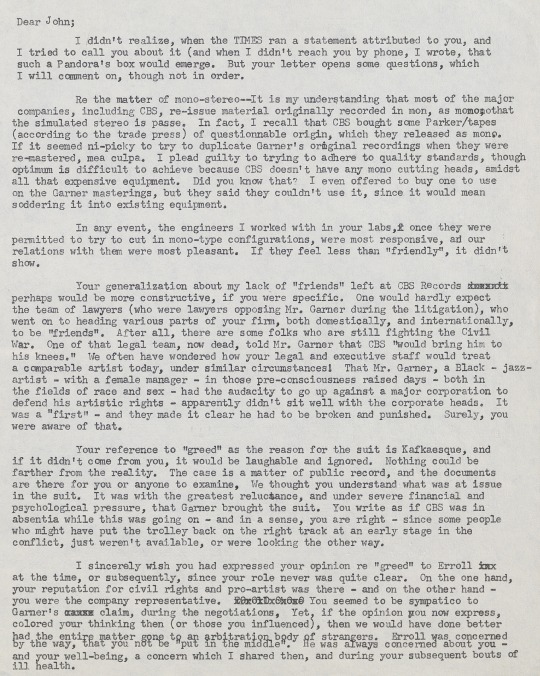
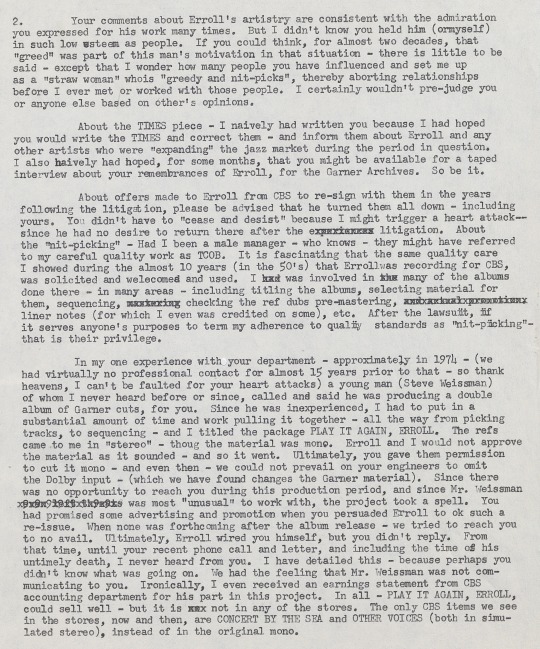

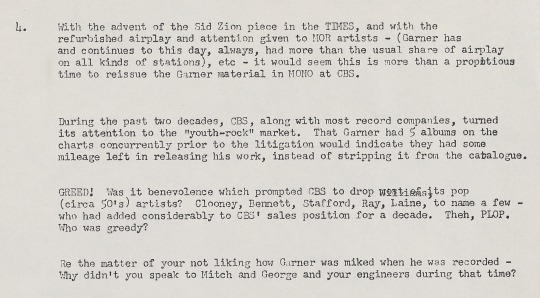
(Above) Images from folder “Correspondence from John Hammond,” Erroll Garner Archive, 1942-2010, Box 1, Folder 62, Archives & Special Collections, University of Pittsburgh Library System.
The final document in this record appears to be a draft of a letter typed by Glaser before the final version dated September 9,1981. While this document does not have a date, it does follow many of the same points of the dated letter and responds point by point to Hammond’s July 16, 1981 document. This draft has numerous redactions and corrections, and the language in it is much stronger than the one that eventually replaced it, (including one parenthetical where Glaser notes “have to change this” after expressing that Hammond’s letter was “character assassination.”) And it is perhaps for the best that it wasn’t sent, but in it we can see the rage that Glaser had for Hammond and the industry, and the vigor by which she was ready to protect Garner’s reputation and status. This draft letter too shows some significant insight into the things that Glaser thought were important, but (in contrast with the final letter) chose to hold back, almost certainly as a result of professional considerations. She writes “That Mr. Garner, a Black – jazz – artist – with a female manager – in those pre-consciousness raised days – both in the fields of race and sex – had the audacity to go up against a major corporation to defend his artistic rights – apparently didn’t sit well with the corporate heads. It was a ‘first’ and they made it clear he had to be broken and punished. Surely, you were aware of that.”
All in all, through these letters, we can see the conflict between Glaser and Hammond, and the not-so-subtle attempts by both of them to conceal resentment and animosity. Hammond’s position of power and reputation in the industry allowed him to feign magnanimity, but Glaser had neither the luxury nor the desire to sugar coat her arguments, although we can see from the differences in her brutal draft letter from her significantly more (but not entirely) diplomatic final letter version that she did take these things into consideration. In the end, Glaser once again proved that she would stand up for Garner against even industry giants like John Hammond, in a way that was uniquely her own.
Works Cited
Erroll Garner Archive, 1942-2010, AIS.2015.09, Archives & Special Collections, University of Pittsburgh Library System.
Goodman, George. "MILES DAVIS: 'I JUST PICK UP MY HORN AND PLAY'." The New York Times. June 28, 1981. Accessed April 27, 2021. https://www.nytimes.com/1981/06/28/arts/miles-davis-i-just-pick-up-my-horn-and-play.html.
Ouellette, Dan. "The True Story of Erroll Garner, the First Artist to Sue a Major Label and Win." Variety. December 02, 2019. Accessed April 27, 2021. https://variety.com/2019/music/news/the-true-story-of-erroll-garner-the-first-artist-to-sue-a-major-label-and-win-1203413083/.
#erroll garner#erroll garner tuesdays#jazz#martha glaser#correspondence#music business#columbia records#octave records
4 notes
·
View notes
Text
His Old Tribulations, Our Current Struggle: Remembering Garner in the Current Call to Reform Cannabis Laws
This post was written by Warner Sabio Sr., Graduate Student, Jazz Studies, University of Pittsburgh.
Recently, on April 7th, Virginia’s legislature passed a bill legalizing the possession of small amounts of marijuana, making it the 16th state to do so. Under Virginia’s law, adults can possess an ounce or less of marijuana beginning July 1. Several weeks before, New York passed the Marijuana Regulation and Taxation Act, legalizing the recreational use of marijuana in the state. New York’s legislation also expunges the records of people convicted on marijuana-related charges that are no longer criminalized. These two drug-policy reforms concerning marijuana are a few of the many looking to respond to the disproportionate and often tragic impact previous legislation has had on communities of color.
For Erroll Garner, the drug policies regarding marijuana and the enforcement of those laws affected him personally and professionally. On January 26, 1946, Garner was arrested in Los Angeles and charged with violating section 11500 of the California Health and Safety Code—a felony at the time. The State accused Garner of possessing “flowering tops and leaves of Indian Hemp (Cannabis Sativa)” and set bail at $500. According to dollartimes.com, adjusted for inflation, $500 in 1946 is equal to $7,156 in 2021. An excessive amount, it seems, for the non-violent crime he was accused of committing. Nevertheless, on April 10, 1946, Garner pled guilty to the charge and was sentenced to 90 days in the county jail. This incident would mark Garner as a felon and a “dope addict,” in the problematic wording of the language that circulated in press accounts. The distinction would continue to cast its shadow and haunt the pianist for at least another decade, if not the rest of his life.
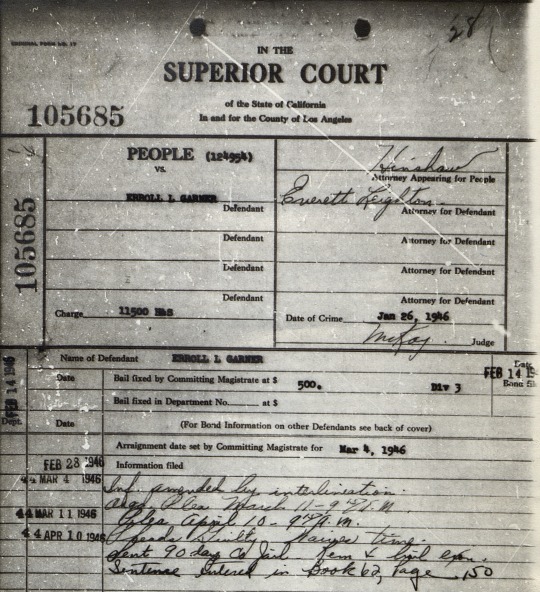
(Above) Page 1, (Below) Page 2, Page 3, Page 4, and Page 11 from folder “Erroll Garner Personal,” Erroll Garner Archive, 1942-2010, AIS.2015.09, Box 3, Folder 18, Archives & Special Collections, University of Pittsburgh Library System.


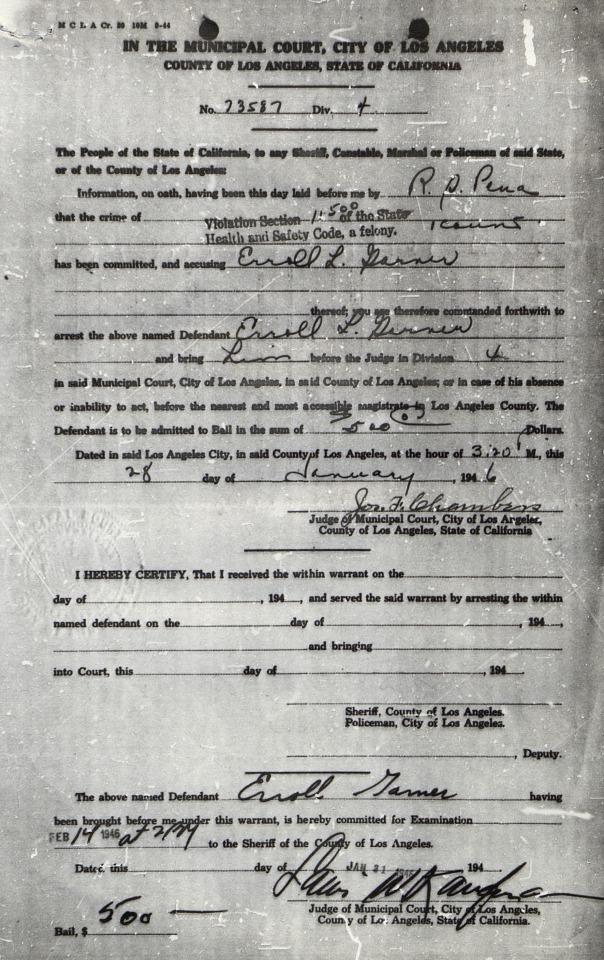
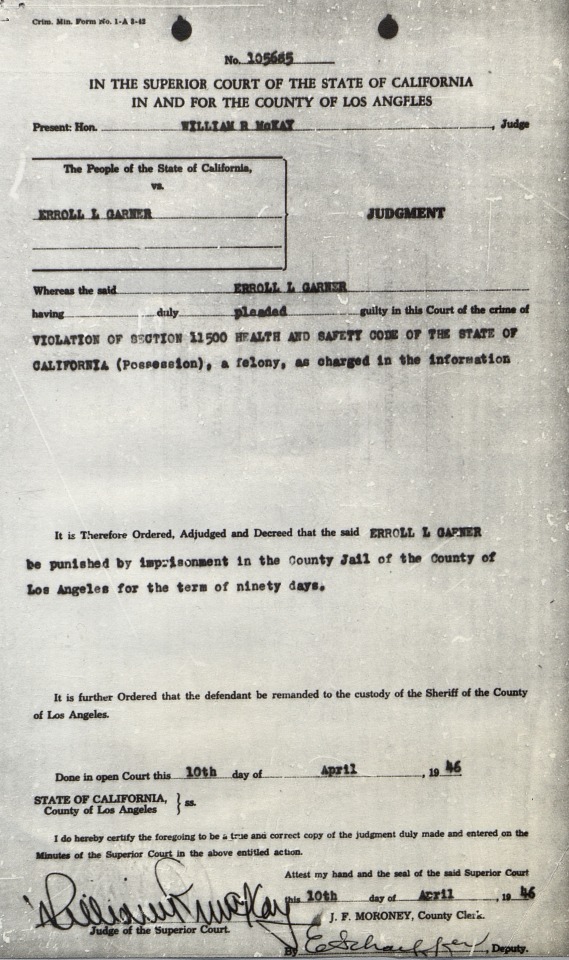
Six years later, after a performance at Mack’s Tavern in Atlantic City on September 12, 1952, the pianist was again arrested and brought up on charges surrounding a marijuana-related drug bust. According to The Baltimore Afro-American, Garner was held “for failure to register as a convicted addict under the state’s narcotics registration law and not for being an actual user of narcotics.”[1] The conviction referred to by New Jersey law-enforcement authorities was based on Garner’s 1946 Los Angeles arrest, which he reportedly informed authorities of at the time. Interestingly, Garner, convicted of possessing marijuana in the initial Los Angeles case, was now branded a “dope addict” in press coverage revolving around the Atlantic City incident.

(Above) Image of the article from The Baltimore Afro-American, Sept. 13, 1952.
The headline on the front page of September 13, 1952, Pittsburgh Courier read: “ARREST ERROLL GARNER FOR DOPE.” The subhead for the article noted that Garner was “Part of Big-Time Roundup.” The lede stated:
ATLANTIC CITY – Erroll Garner, Pittsburgh’s significant gift to jazz and dexterous piano-playing, was nabbed here in a post-Labor Day roundup of alleged dope addicts and suspects.”[2]
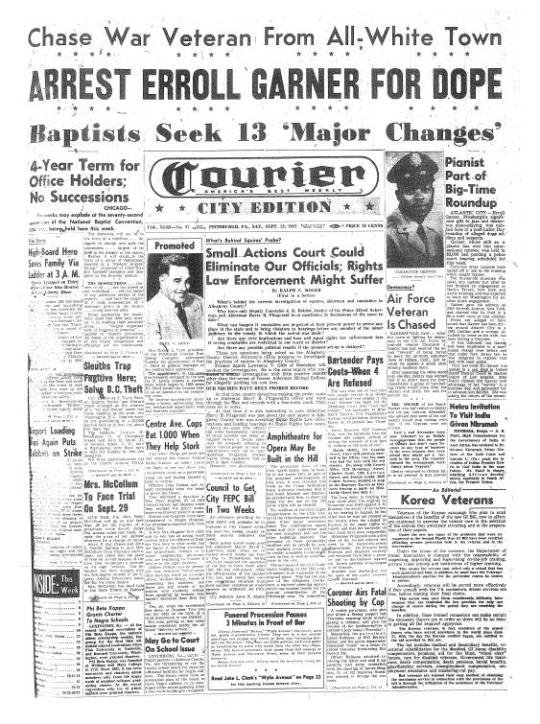
(Above) The Pittsburgh Courier, Sept. 13, 1952.
The Courier also reported that forty-one other suspects were also arrested. One of those arrested included Garner’s roommate and valet, Frank (Tons) Randolph, who was accused of “being a dope peddler.” The Afro-American reported Randolph “was placed under $25,000 bail after two witnesses testified in Municipal Court on Monday that they bought marihuana in $10 and $20 lots from him.” According to dollartimes.com, adjusted for inflation, $25,000 in 1952 is equal to $245,730 in 2021. From the reports, it does not appear that authorities found any weed on Garner or Randolph. Nevertheless, it seems the testimony was enough to warrant the arrests.
It is also interesting to note that the Courier report hinted at a possible ulterior motive for the arrest. Perhaps stemming from the practice of racial profiling of Black men driving nice cars, the paper reported, “police are alleged to have stated that Garner has been driving around Atlantic City in a 1952 Cadillac and a woman, described by some as his wife has been driving a Chrysler.”
In a follow-up story on September 20, The Afro-American interviewed Garner about the arrest. The headline read: “GARNER SHRUGS OFF DOPE COUNT ARREST: ‘Just One Of Those Things,’ Pianist Says of Shore Incident.”[3] Garner discusses the Los Angeles case in the piece, affirming his conviction (saying it took place in 1943) and stating he was “sentenced to 45 days to an honor farm.” Garner elaborated:
“It was all a ‘frame.’ I was turned in by a fellow whose job I took in a night club in which I was playing. The guy was salty and squealed. But I am not complaining because it did happen. At the time, I was a youngster and went around with a bunch of wild guys.”

(Above) Headline from The Baltimore Afro-American, Sept. 20, 1952.
As for the Atlantic City incident, Garner was quoted as saying he “was through with that kind of stuff now” and had “too much to lose.” However, he was critical of the publicity, stating, “the only thing is that I was the least involved and got most of the publicity. This is one time that I wished I was digging ditches.”
Almost a month after the Atlantic City arrest, on October 11, 1952, The Afro-American reported that Garner was fined $50 for failure to register as a dope addict.[4] The case was thereafter dismissed, and Garner “filed the necessary registration forms in compliance with the local ordinance. According to the paper, the incident had left Garner feeling “disturbed” and “embarrassed.” Garner was forced to cancel several weeks of bookings “in order to permit him to rest” because he was “suffering from nervous exhaustion.” As for Randolph and the others arrested that night, my limited search came up empty as to how they fared.
On Jan.17, 1953, the Courier reported that a case involving Garner’s arrest in St. Louis on New Year’s Eve was tossed. Garner was charged with possession of narcotics.[5] The paper said, “Garner’s case was thrown out of court because the officers did not have a warrant when the arrest was made.” Garner’s attorney, however, clarified that the basis of the arrest was “a crank telephoned St. Louis police that the pianist had carried narcotics from New York to St. Louis in his automobile. It was revealed that Garner had arrived in this city by plane.”
For Pittsburgh-born Garner, professional success could not shield him from the insatiable appetite to punish that has driven much of the nation’s drug policies for decades. Major players in the formation of these early policies are uniquely linked to Garner geographically. Harry J. Anslinger, who served as the first commissioner of the U.S. Treasury Department’s Federal Bureau of Narcotics, was an Altoona, PA native. Pittsburgh’s-own Andrew Mellon, the uncle of Anslinger’s wife, appointed him to the post. Mellon, at the time of Anslinger’s appointment, was the Treasury Secretary.
According to The Economist:
“The drafters of the Harrison Act of 1914, the first federal ban on non-medical narcotics, played on fears of ‘drug-crazed, sex-mad negroes.’ And the 1930s campaign against marijuana was coloured by the fact that Harry Anslinger, the first drug tsar, was appointed by Andrew Mellon, his wife’s uncle. Mellon, the Treasury Secretary, was banker to DuPont, and sales of hemp threatened that firm’s efforts to build a market for synthetic fibers. Spreading scare stories about cannabis was a way to give hemp a bad name. Moral outrage is always more effective if backed by a few vested interests.”[6]
According to law professor Michael Vitello, “while the Harrison Act did not include a prohibition against marijuana, its framework would become the model for Congress’s first efforts to criminalize marijuana.”[7]

(Above) Harry J. Anslinger served as the first commissioner of Treasury Department’s Federal Bureau of Narcotics. Image from the Associated Press.
Driven by stereotypes, some framers of early U.S. drug policies linked the usage of both marijuana and cocaine to marginalized communities and racialized “fringe groups like pimps, prostitutes, and day laborers” and “uppity Southern blacks and race-mixing drug parties.”[8] Concerning Anslinger’s beliefs, Vitello states:
“Finding racist quotations attributed to Anslinger is easy and a reminder of how ingrained racist language was in this country. Here are a few choice quotations: “Reefer makes darkies think they’re as good as white men”; “Marihuana influences Negroes to look at white people in the eye, step on white men’s shadows and look at a white woman twice”; and “There are 100,000 total marijuana smokers in the U.S., and most are Negroes, Hispanics, Filipinos and entertainers. Their Satanic music, jazz and swing result from marijuana use. This marijuana causes white women to seek sexual relations with Negroes, entertainers and any others.”[9]
These antiquated and racist beliefs would vibrantly pulsate through the heart of drug laws for generations. Unfortunately, Garner’s experience was not isolated or rare. For Garner, the arrests and court cases must have been taxing. His experience speaks for many people caught up in the web of draconian drug laws pervading the justice system. The growing frustration has led to calls for change.
As previously mentioned, recent efforts have yielded changes to drug policy concerning marijuana across the United States. To date, sixteen states, two territories, and the District of Columbia have legalized small amounts of marijuana for adult recreational use. Twenty-seven states have decriminalized weed, meaning, “small, personal-consumption amounts are a civil or local infraction, not a state crime (or are a lowest misdemeanor with no possibility of jail time).”[10] However, more needs to be done to undo the gross injustice that lopsided enforcement has produced. It is a flawed system of policies and laws that impacted Garner then and thousands today. We must resolve the discordant tones struck by the framers of foundational drug war policies, the effects of which still resonate and impact civil society today.
Works Cited
Erroll Garner Archive, 1942-2010, AIS.2015.09, Archives & Special Collections, University of Pittsburgh Library System.
“Arrest Erroll Garner For Dope: Pianist Part of Big-Time Roundup.” Pittsburgh Courier (Pittsburgh, Pa.), September 13, 1952: 1.
Bender, Steven W. “Joint Reform? The Interplay of State, Federal, and Hemispheric Regulation of Recreational Marijuana and Failed War on Drugs.” Albany Law Environmental Outlook 6, no. 2 (2013): 359–.
“Errol Garner Case Thrown Out of Court.” Pittsburgh Courier (Pittsburgh, Pa.), January 17, 1953: 1.
“Errol Garner Pays $50 Fine: Failed To Register As Dope Addict.” Baltimore Afro-American (Baltimore, Md), October 11, 1952: 9
“Garner Shrugs Off Dope Count Arrest: ‘Just One Of Those Things,’ Pianist Says Of Shore Incident.” Baltimore Afro-American (Baltimore, Md), September 20, 1952: 3
Gootenberg, Paul. Andean Cocaine: The Making of a Global Drug. Chapel Hill, NC: University of North Carolina Press, 2008.
“‘How did we get here?’ A Survey of Illegal Drugs.” Economist, July 28, 2001, p. 4. The Economist Historical Archive, 1843-2015 (accessed April 13, 2021). https://link-gale-com.pitt.idm.oclc.org/apps/doc/GP4100323851/ECON?u=upitt_main&sid=ECON&xid=779492d4.
“Pianist Under Bail For Not Registering As Addict; Shore’s Raids Called Biggest.” Baltimore Afro-American (Baltimore, Md), September 13, 1952: 1
National Conference of State Legislatures website, https://www.ncsl.org/research/civil-and-criminal-justice/marijuana-overview.aspx
Vitiello, Michael. “Marijuana Legalization, Racial Disparity, and the Hope for Reform.” Lewis & Clark Law Review 23, no. 3 (2019): 789-822.
[1] “Pianist Under Bail For Not Registering As Addict; Shore’s Raids Called Biggest,” Baltimore Afro-American (Baltimore, Md), September 13, 1952.
[2] “Arrest Erroll Garner For Dope: Pianist Part of Big-Time Roundup,” Pittsburgh Courier (Pittsburgh, Pa.), September 13, 1952.
[3] “Garner Shrugs Off Dope Count Arrest: ‘Just One Of Those Things,’ Pianist Says Of Shore Incident,” Baltimore Afro-American (Baltimore, Md), September 20, 1952.
[4] “Errol Garner Pays $50 Fine: Failed To Register As Dope Addict.” Baltimore Afro-American (Baltimore, Md), October 11, 1952.
[5] “Errol Garner Case Thrown Out of Court.” Pittsburgh Courier (Pittsburgh, Pa.), January 17, 1953: 1.
[6] “‘How did we get here?’ A Survey of Illegal Drugs,” Economist, July 28, 2001.
[7] Michael Vitiello, “Marijuana Legalization, Racial Disparity, and the Hope for Reform,” Lewis & Clark Law Review 23, no. 3 (2019), 794.
[8] Paul Gootenberg, Andean Cocaine: The Making of a Global Drug, Chapel Hill, NC: University of North Carolina Press, 2008, 193.
[9] Vitiello, “Marijuana Legalization,” 799.
[10] National Conference of State Legislatures website, https://www.ncsl.org/research/civil-and-criminal-justice/marijuana-overview.aspx
#erroll garner tuesdays#erroll garner#criminalization#newspapers#cannabis laws#drug policy#harry anslinger#racism
3 notes
·
View notes
Text
Mementos of Exhaustion
This post was written by YuHao Chen, graduate student in ethnomusicology, University of Pittsburgh.
Christmas season at Martha Glaser’s management office was quite a juggling act. It was colored by the daunting task of preparing gifts for a plethora of business correspondence and services all over the country that, in one way or another, supported the success of Erroll Garner's jazz career and Octave Records, his joint enterprise with Glaser. From big-name news press, record companies, and piano dealers to behind-the-scenes personnel such as bellmen, operators, desk clerks, and maids, the names went on and on. Lists like this one permeate Glaser’s daily notes around Christmastime, revealing the extent to which the acrobatics of professionalism must be carried into the New Year, even when the corporate world seemed to doze off momentarily. As the year would wind down, Glaser’s firm hummed with business as usual.

Image from folder “Martha Glaser Daily Notes,” Erroll Garner Archive, 1942-2010, Box 73, Folder 5, Archives & Special Collections, University of Pittsburgh Library System.
However, the 1968 Christmas season was unlike any other.
Glaser was ill. In fact, she had been sick “with [a] virus since August.” By December she had run out of steam and was teeming with spite, fury, pride, repentance, and remorse among other complicated feelings—all shoved up against the uncomfortable truth that she had been overworking with pain since college. Her complex interiority spilled out onto a note dated Friday December 13th, 1968 that cracked open a crevice for an unsung voice. With fumbling steps, she appeared exhausted by her own heroism. For a moment, she loosened her posture as a staunch businesswoman, whose shadow was cast so laboriously onto the career of “the bull named Garner.”
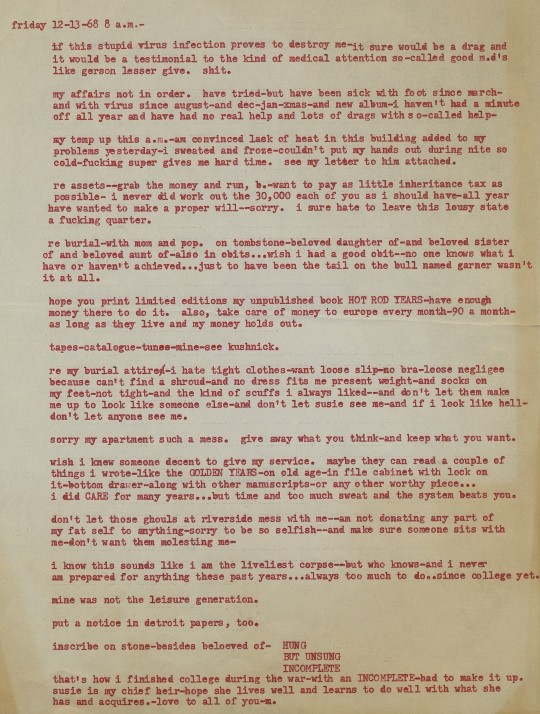
Image from folder “Martha Glaser Daily Notes,” Erroll Garner Archive, 1942-2010, Box 73, Folder 5, Archives & Special Collections, University of Pittsburgh Library System.
Readers familiar with Glaser’s writing will likely recognize her idiosyncratic voice in this personal note. Previous blog posts have commented on the distinctly brisk, unapologetically blunt, and stubbornly snappy tone that is Glaser’s. See, for example, The “Swinging City Revolution”: Garner in the Land of the Rolling Stones, Martha Glaser Fights for Garner’s ASCAP Holdings, Martha’s Private Writings, and Three Shades of Martha. In the face of the still discriminatory American music industry, Glaser’s fierceness was indeed what it took for her in the mid-twentieth century to procure the professional recognition she deserved.
In comparison, the December 13th private note appears markedly different from Glaser’s other writings in the archive in that it seems to withdraw from the career game that she is so adept at playing. Under what normal circumstance would we ever expect lamentation like “but time and too much sweat and the system beats you” coming from a powerhouse like Glaser? At the same time, her vehement verbal attack against a line of adversaries—the virus, lousy medical attention, state tax, tight clothes, and “those ghouls at riverside”— is reminiscent of her typical professional demeanor. It is as if the prospect of dying, or her realization of an existential pushback, only inspired her to remain the witty fighter—or “the liveliest corpse,” as she puts it—up to her last dying breath.
Glaser seems undeterred by the collapse between the professional and the private amidst high fever and shivering hands. Within the space of a single typed page, she sprints across a variety of contexts: her illness, business, assets, complaints, relationship with Garner, wishes, worth, tombstone, afterlife, and younger self. And she does so with such speed and abandon, as though affirming the cliché that upon dying one’s entire life would flash before one’s eyes. If that is indeed the case, what does Glaser’s note tell us about her life? Should the note be considered a heart-wrenching meditation on death? Or a tongue-in-cheek commentary on the capitalist hold that monetizes her last fragments of unfulfilled dreams?
But even as Glaser undertook such ruminations, the holiday season marched on. Her office memos around Christmas illustrate the kind of professional responsibilities that she typically bore as an unwavering advocate for Garner’s music. Piles of thank-you cards and gifts stuffed her Christmas season, waiting to be mailed out. Archival materials from 1968 show that the seasonal business ritual began around December 7th and lasted all the way to the 30th, with Glaser’s assistants Ada Roeter and D. Murray reporting throughout the month on their progress of sending out holiday greetings in addition to managing routine tasks like handling contracts, calls, and files.
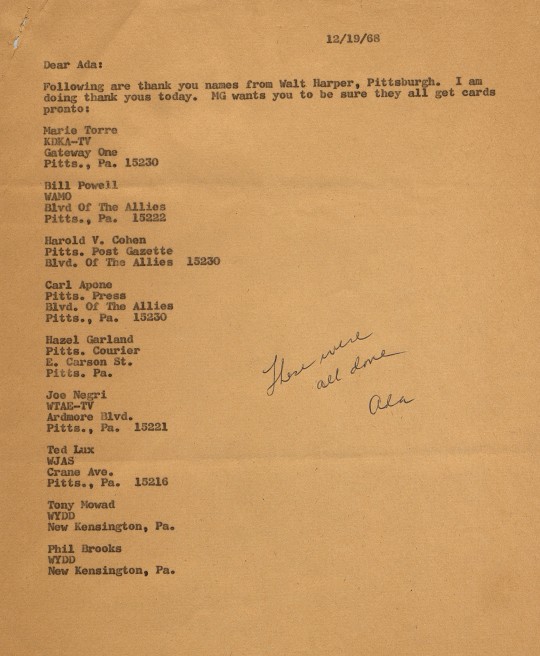
Image from folder “ Martha Glaser Incoming Correspondence 1966-1969,” Erroll Garner Archive, 1942-2010, Box 69, Folder 12, Archives & Special Collections, University of Pittsburgh Library System.

Image from folder “ Martha Glaser Incoming Correspondence 1966-1969,” Erroll Garner Archive, 1942-2010, Box 69, Folder 12, Archives & Special Collections, University of Pittsburgh Library System.
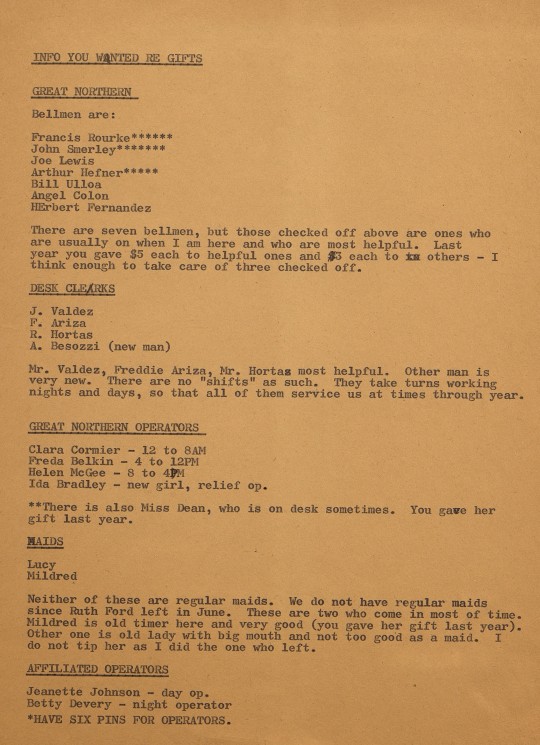
Image from folder “ Martha Glaser Incoming Correspondence 1966-1969,” Erroll Garner Archive, 1942-2010, Box 69, Folder 12, Archives & Special Collections, University of Pittsburgh Library System.
The materials held in the archive seem to suggest that Glaser composed very few business memos that Christmas, likely because she was too ill to work. On Christmas Day, she received the following telegram from Garner: “TAKE CARE GET WELL HAPPY XMAS I AM WITH YOU ALL THE WAY YOU ARE NOT ALONE.” On January 24th the following year, she wrote to Howard (presumably Howard Beldock, one of her attorneys in the late 1960s) to convey details about her own personal beneficiaries and assets, a process which was already on her mind as early as September 1st, 1967, when she wrote in her daily notes “complete new will – me –.”
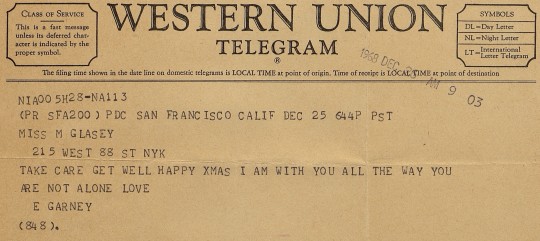
Image from folder “Correspondence between Erroll Garner and Martha Glaser,” Erroll Garner Archive, 1942-2010, Box 3, Folder 5, Archives & Special Collections, University of Pittsburgh Library System.
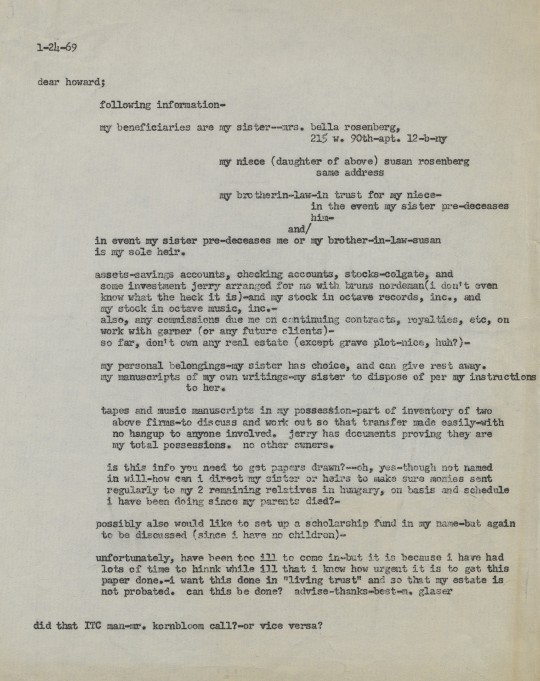
Image from folder “Martha Glaser Daily Notes,” Erroll Garner Archive, 1942-2010, Box 73, Folder 5, Archives & Special Collections, University of Pittsburgh Library System.
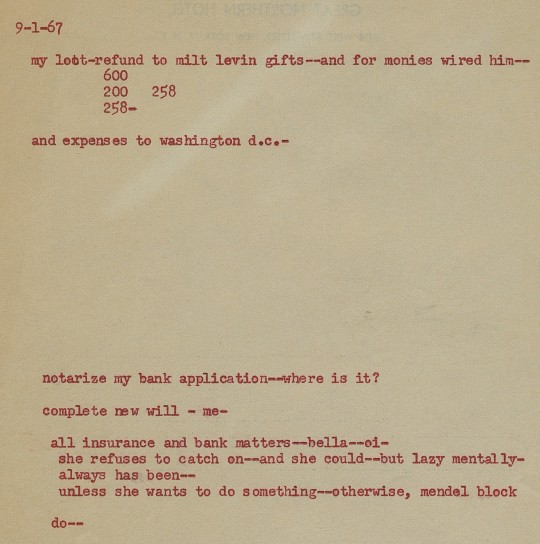
Image from folder “Martha Glaser Daily Notes,” Erroll Garner Archive, 1942-2010, Box 73, Folder 5, Archives & Special Collections, University of Pittsburgh Library System.
With these surrounding events in mind, we might begin to see Glaser’s note of December 13th as an outburst of exhaustion irritated by her longstanding battles in the professional arena. Glaser’s feistiness seems so well-rehearsed in this note because dying, like other events in life, was so bound up with professional responsibilities that it demanded her to navigate mortality with the business strategies she mastered. Her sarcastic remark at her own dying does not necessarily neutralize its possibility but, rather, exaggerates its poignancy, exposing the range of expression available to her through rounds after rounds of tough negotiation in music industry and in life.
Which leaves us with one final question: who was Glaser writing for? While this note is intensely private, there is also a sense of dialogue and an implied audience. She wrote sentences like “hope you print limited editions my unpublished book” and “sorry my apartment such a mess. give away what you think—and keep what you want.” Who is the “you”? Is it the nosey neighbor who might discover the hypothetically dead body of Glaser? The unnamed relative to whom she gave burial instructions? Or anyone who might stumble upon her death note? Glaser lived well into the millennium; she died in 2014. Yet her note from 1968 continues to lay silently among the mass of the Erroll Garner Archive, like a corpse waiting to be found. As readers of Glaser’s memento, we are not unlike that unnamed relative, that coincidental reader who, upon entering her embalmed past, expected to rescue a yellowed body—only to catch lines upon lines of redness, inscribing an undying voice gregariously ruminating different life endings, suspended within the tomb of time forever pivoting.
1 note
·
View note
Text
The “Swinging City Revolution”: Garner in the Land of the Rolling Stones
This post was written by Deanna Witkowski, pianist-composer, graduate student in Jazz Studies at the University of Pittsburgh, and author of Mary Lou Williams: Music for the Soul (Liturgical Press, August 2021).
In May and June of 1966, Erroll Garner played in London for several weeks with his longtime triomates, bassist Eddie Calhoun and drummer Kelly Martin. Leslie (Les) Perrin and Associates, publicity firm for the Rolling Stones and other big name pop acts, served as Garner’s publicist for his English tour dates. In many photos from 1966-1970, Perrin is seen with the Stones, Frank Sinatra, and Joni Mitchell. Mitchell’s website includes a feature page on Perrin with this article from a tabloid-looking paper entitled “Weekend— Feb. 25-Mar. 3, 1970.”
On June 12, after Garner had already been in England for over two weeks, Glaser typed a letter to Perrin, chastising him for not contacting her with any press coverage of Garner’s tour dates thus far—or, for that matter, with any news at all. Dispensing with formal niceties, Glaser begins her correspondence using all capital letters: “ABSOLUTELY NOTHING RECEIVED FROM YOU (EXCEPT BRIEF CABLE THIS WEEK) since tour began. Our disappointment beyond expression. We needed reviews for Variety ad. Blew the space reservation since you didn’t send reviews.”

Image from folder “Correspondence from Leslie Perrin (Associated LTD. UK Bookers),” Erroll Garner Archive, 1942-2010, Box 1, Folder 119, Archives & Special Collections, University of Pittsburgh Library System.
As in my earlier post on his 1959 date at Kleinhans Music Hall in Buffalo, Glaser’s letter shows the interdependence of multiple behind-the-scenes players in shaping Garner’s career. Glaser cannot move forward with future publicity needs until Perrin generates publicity for the current tour and communicates the results of that publicity with her.
Glaser pulls no punches in her critique of Perrin—and is compelled to fight these battles so that Garner can focus on his own labor: creating music. Two-thirds of the way through her letter, she writes, “I can only surmise that with the ‘swinging city revolution’ of London, as we keep reading, your office has become too busy to write us . . . Leslie—I don’t know how or why this tour is different—but your silence and the lack of any written word from [Jack] Higgins or Harold [Davison] leads me to conclude that your operations now have bigger-money projects, and that is that.”
The two other names that Glaser mentions, Jack Higgins and Harold Davison, are additional players in Garner’s British tour production and publicity. Both names appear on the final page of this program from June 11, 1966:
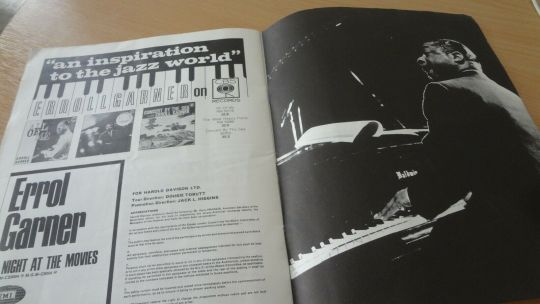
(Above) “Erroll Garner Souvenir Brochure London, November 6, 1966.” PicClick UK. Accessed April 5, 2021. https://picclick.co.uk/1966-Erroll-Garner-Souvenir-Brochure-London-11-06-1966-373506567730.html.
Davison is listed as being the concert presenter, with Higgins handling “promotion direction” and Dougie Tobutt handing “tour direction.”
Enclosed with her letter Glaser includes a marked-up copy of a document titled “Backgrounder to Erroll Garner,” a one-sheet apparently created by Perrin for local press reporters. Claiming to provide “a fact-a-phrase for journalists-in-a-hurry,” the document is a list of twelve bullet-point facts about Garner.
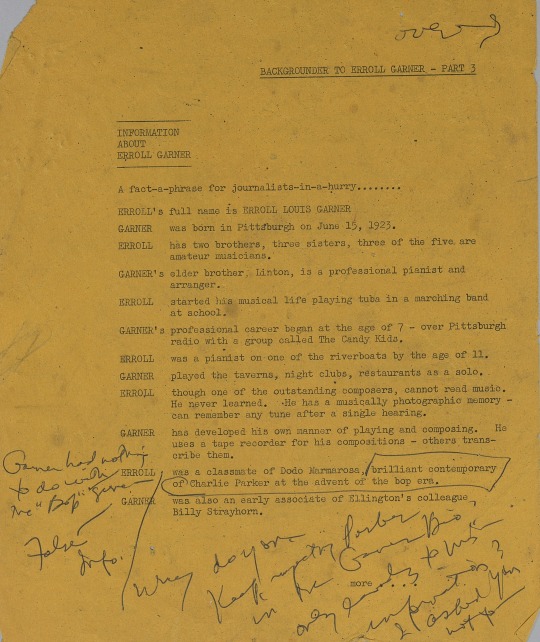
Image from folder “Correspondence from Leslie Perrin (Associated LTD. UK Bookers),” Erroll Garner Archive, 1942-2010, Box 1, Folder 1119, Archives & Special Collections, University of Pittsburgh Library System.
In response to two of the points, Glaser pens handwritten corrections:
Where the one-sheet reads:
“ERROLL was a classmate of Dodo Marmarosa, brilliant contemporary of Charlie Parker at the advent of the bop era.”
Glaser responds:
“Garner had nothing to do with the “bop” scene—“ and “Why do you keep repeating Parker in the Garner bio?’” The truth is that Garner was indeed a childhood friend of bop pianist Marmarosa, who recorded with Parker on numerous occasions. Garner recorded with Parker as well, but was not a bop pianist, while Marmarosa was closely identified with that musical style.
And where the sheet reads:
“GARNER was also an early associate of Ellington’s colleague Billy Strayhorn.”
Glaser simply writes: “False info.”
In her letter, she goes into further detail on each point, writing, “I don’t know where this junk about being a contemporary etc of Parker in bog (sic) reveolution (sic) days keeps cropping up from . . .out of context, it is totally misleading.”
And to the second point: “Garner and Strayhorn friends—never associates or associated, in any music situation.”
Perrin did respond to Glaser. Although his reply is undated, it likely followed soon after, as he references recent British concert dates and signs off promising “more tomorrow.” Most importantly, he sends ten quotes on Garner’s appearances from press including Melody Maker, the Evening News, and New Musical Express. He only includes this material, however, after making a snide comment: “My dear Martha, It is a warm afternoon, the shadows are creeping across the desk, and I am asking myself, “Do you think that Martha came to the Albert Hall after all? Because the concert was at the Royal Festival Hall?”

Image from folder “Correspondence from Leslie Perrin (Associated LTD. UK Bookers),” Erroll Garner Archive, 1942-2010, Box 1, Folder 119, Archives & Special Collections, University of Pittsburgh Library System.
Snide comment or not, Perrin produced the results that Glaser was asking for. This snapshot of two documents shows how sharp and direct she had to be in order to acquire the material she needed to continue her own work in moving Garner’s career forward.
————————
For additional listening:
Check out some of the the Garner albums included on the final page of the concert ad shown in the concert program shown above:
CBS ad: Concert by the Sea 1955 https://www.errollgarner.com/listen-new (scroll down)
The Most Happy Piano 1956
youtube
(Above) Audio for “Full Moon and Empty Arms” off The Most Happy Piano by Erroll Garner, originally released in 1957 by Columbia Records.
EMI ad:
A Night at the Movies 1965— original liner notes and audio samples at https://www.errollgarner.com/anightatthemovies-ors
Listen to the all-of-five-seconds “Newsreel Tag (Paramount on Parade)”
youtube
(Above) Audio for “Newsreel Tag (Paramount on Parade)” off A Night at the Movies by Erroll Garner, re-relseased by Octave Records in 2019.
Works Cited:
Erroll Garner Archive, 1942-2010, AIS.2015.09, Archives & Special Collections, University of Pittsburgh Library System.
Erroll Garner - Topic. “Full Moon and Empty Arms.” YouTube Video, 4:19. July 30, 2016. https://www.youtube.com/watch?v=dxlVnUXJApY.
Erroll Garner - Topic. “Newsreel Tag (Paramount on Parade).” YouTube Video, 0:08. October 17, 2019. https://www.youtube.com/watch?v=s0hqVABcPSk
prettyjohn888. “1966 Erroll Garner Souvenir Brochure London 11/06/1966 • £4.00.” PicClick UK. Accessed April 5, 2021. https://picclick.co.uk/1966-Erroll-Garner-Souvenir-Brochure-London-11-06-1966-373506567730.html.
2 notes
·
View notes
Text
Martha Glaser fights for Garner’s ASCAP holdings
This post was written by Adam Lee, graduate student, Jazz Studies, University of Pittsburgh.
Martha Glaser continued to manage Erroll Garner’s business affairs long after the pianist’s death in 1977. Contained in the Erroll Garner Archive are records of correspondence between Garner and the American Society of Composers, Authors, & Publishers (ASCAP), many of which cover decades of rights management for Garner’s estate. Many of these records are handwritten notes referencing which compositions are held by which rights management companies, and what the exact reference numbers are. Others are official typed documents with similar information addressed to or from Martha Glaser in reference to the legal copyright standing of various Erroll Garner compositions. These all show a carefully hands-on approach that Glaser took to managing the rights and royalties of these pieces for Garner, she knew exactly which pieces were held by ASCAP down to their catalog number and kept records of this information. Other documents exist in the archive that support Glaser’s protection of these rights pertaining to companies other than ASCAP, although in the interest of focus I have only chosen to use ASCAP documents for today’s post.
Glaser not only managed Garner’s works, but on at least one occasion, she protected another artist, Red Callender, when his composition “Pastel” was misattributed to Garner in an ASCAP copyright statement. Glaser reached out to ASCAP and had them attribute the piece correctly, and corresponded with Callender on January 18, 1978 about the mistake, inquiring if he was registered with ASCAP or not. This same document reveals that, at least as of 1978, no Garner pieces were held by rival rights company Broadcast Music Inc. (BMI).

Image from folder “Correspondence from Red Rodney,” Erroll Garner Archive, 1942-2010, Box 1, Folder 126, Archives & Special Collections, University of Pittsburgh Library System.
Glaser not only protected Garner’s holdings during his life, but also posthumously managed and protected his copyright ownership. Take for example, this notice to ASCAP assigning rights administration to “WB MUSIC CORP.” from January 1, 1983 of what is most certainly Garner’s most famous composition “Misty”:
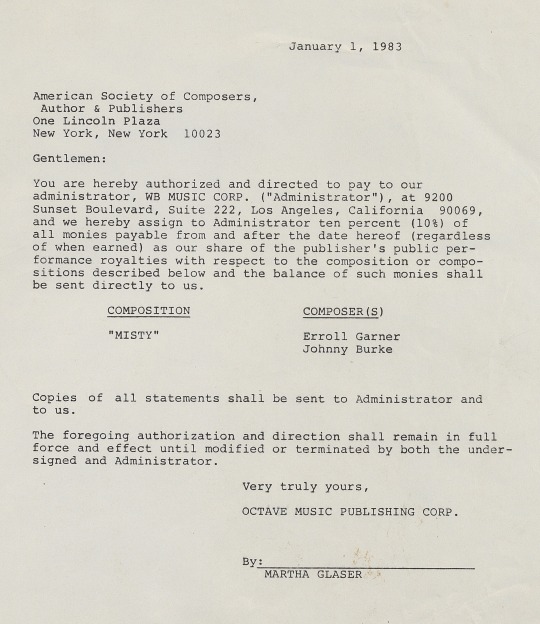
Image from folder “Correspondence from ASCAP,” Erroll Garner Archive, 1942-2010, Box 1, Folder 5, Archives & Special Collections, University of Pittsburgh Library System.
Glaser also oversaw the termination of that above agreement with WB Music Corp a full fifteen years later, with correspondence detailing the cessation of the contract going to both WB Music and ASCAP effective March 31, 1996.
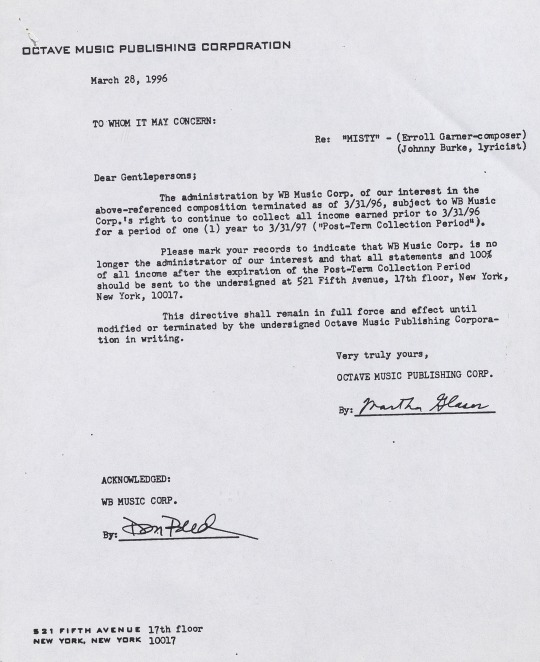
Image from folder “Correspondence from ASCAP,” Erroll Garner Archive, 1942-2010, Box 1, Folder 5, Archives & Special Collections, University of Pittsburgh Library System.
It is notable that Glaser uses her own archive of these documents in order to be able to support her rights management claims. She is able to refer to the exact dates and recipients of previous letters, and calls them up in order to clear up discrepancies in her correspondence with the ASCAP administration, as she does in a July 21st, 1996 letter:
This letter was sent to numerous persons at ASCAP at the time, including Carmella Reilly, Paula Perry, Maria Sotomayer. That you only have learned of the re-assignment now is puzzling. In any event, we trust that your computers show the correct accreditation.
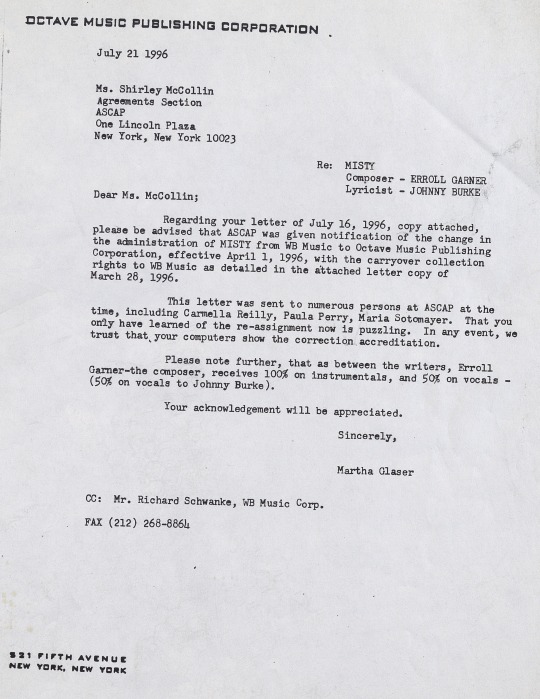
Image from folder “Correspondence from ASCAP,” Erroll Garner Archive, 1942-2010, Box 1, Folder 5, Archives & Special Collections, University of Pittsburgh Library System.
There was clearly some delay in handling of the paperwork properly on ASCAP’s part, and Glaser didn’t hesitate to point out that she was aware of the problem and not going to let it slide any further.
Eleven years later, in 2007, the archive contains a detailed breakdown of broadcast performances of “Misty” and the royalty credits earned per broadcast, as collected by ASCAP. It also includes an image of a check to the Garner trust in the sum of $3044.09 for the 2006 quarter spanning from October to December. These documents also contain a letter with a tantalizing reference to the beginnings of internet streaming as a method of content delivery:
On May 8, 2007, John LoFrumento posted a letter on ASCAP’s website to all our members. It addressed the recent court decision concerning the existence of a performing right in a download…ASCAP’s position, as always, was and is to ensure that you receive all the compensation to which you are legally entitled.
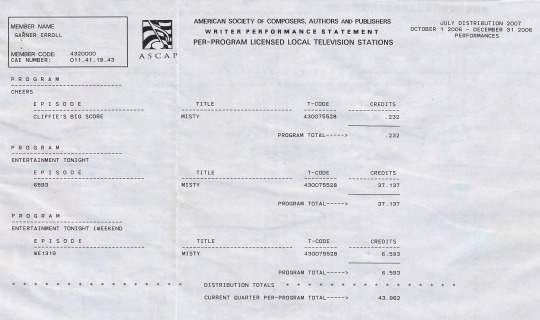
Image from folder “Correspondence from ASCAP,” Erroll Garner Archive, 1942-2010, Box 1, Folder 5, Archives & Special Collections, University of Pittsburgh Library System.
The above breakdown of royalty rights for “Misty” indicates that Garner was entitled to .747 credits worth of royalties from “Internet – Streaming” as the source. I am unclear exactly how the number of credits accrued from this source was calculated, but I am curious as to how this stacks up against the streaming giants of 2021 in terms of royalties received? The letters indicate this would have been about $5.42 in 2007. The website visualcapitalist.com suggests that it would take around 1400 streams to make that amount (not adjusted for inflation) in 2021.
Glaser was also careful to make sure that the royalties from ASCAP were paid to the correct people and in the correct accounts. A letter on behalf of Glaser is sent to ASCAP by CPA Steven Smallowitz on September 21, 2007 which asks ASCAP to ensure that payments are going to the correct accounts, split between the publisher and the composer’s estate properly.
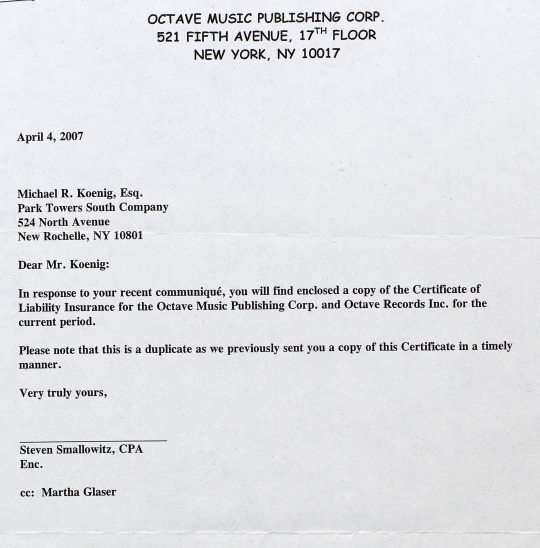
Image from folder “Martha Glaser, Legal; banking,” Erroll Garner Archive, 1942-2010, Box 2, Folder 35, Archives & Special Collections, University of Pittsburgh Library System.
These documents all serve to demonstrate a careful attention to the financial details of Erroll Garner’s copyrights and royalties. This is in sharp contrast to the long-held narrative within jazz history canon of companies and managers taking advantage of artists for their own profit. Glaser both proves through her action, and the documentation supporting that action, that she was acting in Garner’s best financial interests, even three decades after his passing.
0 notes
Text
In a night of stars, Garner sparkles in his support of the NAACP
This post was written by Warner Sabio Sr., Graduate Student, Jazz Studies, University of Pittsburgh.
On Monday, March 23, 1953, Erroll Garner took part in a star-studded affair held at New York City’s Madison Square Garden. The event was the NAACP’s Second Annual “Big Nite,” which featured a host of artists from cinema, TV, radio, and theater. Joining Garner and his trio were Lena Horne, Cab Calloway, W.C. Handy, Ossie Davis, Eartha Kitt, the Nicholas Brothers, Danny Thomas, Ed Sullivan, Imogene Coca, and Pearl Primus, along with other entertainers that came together to raise money for the organization.[1] According to the Amsterdam News, the arena was filled with 10,000 supporters and well-wishers surrounded by large banners announcing, “FOR A FREE AMERICA,” “JIM CROW MUST GO … NOW.”
On July 13, 1953, Rufus W. Smith, chairman of the Madison Square Garden Benefit, wrote to Garner, in care of Martha Glaser, thanking him for his performance and donation. Smith stated, “Your participation in our Second Annual Madison Square Garden Benefit was indeed an enjoyable occasion to the thousands present. Your performance was a highlight to the occasion.”

Image from folder “Erroll Garner Personal,” Erroll Garner Archive, 1942-2010, Box 3, Folder 16, Archives & Special Collections, University of Pittsburgh Library System.
Enclosed was a receipt dated June 22, 1953, for Garner’s contribution, in the form of a refund, of $107.25 to the organization. The value of that contribution today, adjusted for inflation, would be approximately $1,046.29.[2]
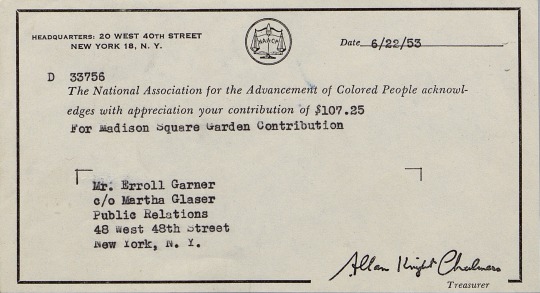
Image from folder “Erroll Garner Personal,” Erroll Garner Archive, 1942-2010, Box 3, Folder 16, Archives & Special Collections, University of Pittsburgh Library System.
The receipt and letter from Smith found in the Garner archive is one item that points to the musician’s engagement with the Civil Rights Movement of the era.
Notably, in 1953, the NAACP was firmly committed to ending segregation in the U.S. by adopting a litigation strategy targeting Jim Cow legislation. Led by then-attorney Thurgood Marshall, who worked with the organization in tandem with NAACP Legal Defense and Educational Fund, the civil-rights group was litigating Brown v. Board of Education at the U.S. Supreme Court. Garner’s Madison Square Garden appearance, and his subsequent donation, helped provide much-needed funds for the group to continue legal battles and other civil-rights efforts. Within a short period, the NAACP would win a decisive decision that would dramatically shift the country. More than a year after the benefit show, on May 17, 1954, the U.S. Supreme Court ruled unanimously that racial segregation of children in public schools was unconstitutional. This ruling would serve as a cornerstone in the fight to end segregation.
Garner was no stranger to this fight. He quietly made efforts to take on segregation and push for equality and racial harmony in his personal and professional life, as detailed by his manager Martha Glaser. Shortly after he died in 1977, Glaser responded to a February 10th, 1977 obituary in Rolling Stone magazine. Nat Hentoff, the famed jazz critic, penned the piece, which Glaser appreciated yet felt was incomplete and lacking in depth.

Image from folder “Martha Glaser Outgoing Correspondence,” Erroll Garner Archive, 1942-2010, Box 68, Folder 26, Archives & Special Collections, University of Pittsburgh Library System.
Writing to the editors, Glaser stated, “Garner also had a clause in his contracts BEFORE the 1954 Supreme Court decision, forbidding segregation of any kind in the audience, backstage, facilities, etc., at any appearance. He always wanted a ‘salt and pepper’ audience. There is much to be told about how this quiet man fought many battles which cleared the way for other performers. He did it without fanfare or awards.” I hope that Garner, through the efforts of scholars engaging with the archive, gets his due.
[1] “All Roads Lead to Madison Square Monday: Stars Will Shine at NAACP 'Great Night'” New York Amsterdam News (1943-1961), City edition; New York, N.Y. [New York, N.Y]21 Mar 1953: 26; Alvin Chick Webb, “There Were Stars Galore at NAACP Benefit: Canada Would've Loved NAACP's 'Great Night,'” New York Amsterdam News (1943-1961), City edition; New York, N.Y. [New York, N.Y]28 Mar 1953: 28.
[2] Value determined on March 17, 2021 using https://www.dollartimes.com/inflation calculator.
Works Cited
“All Roads Lead to Madison Square Monday: Stars Will Shine at NAACP’s ‘Great Night,’” New York Amsterdam News, 21 March 1953, pp. 26.
Alvin Chick Webb, “There Were Stars Galore at NAACP Benefit: Canada Would’ve Loved NAACP’s ‘Great Night,’” New York Amsterdam News, 28 March 1953, pp. 28.
0 notes
Text
Analogizing with Garner the Rabbit
This post was written by YuHao Chen, graduate student in ethnomusicology, University of Pittsburgh.
Let’s take for example a drawing in jazz pianist Erroll Garner’s letter to his manager Martha Glaser in Spring 1967, where he asks for her forgiveness, after having walked out with the money that he should have left at the office. In a way, analogy creates an illusion of intimacy by casting two separate things within one thought.
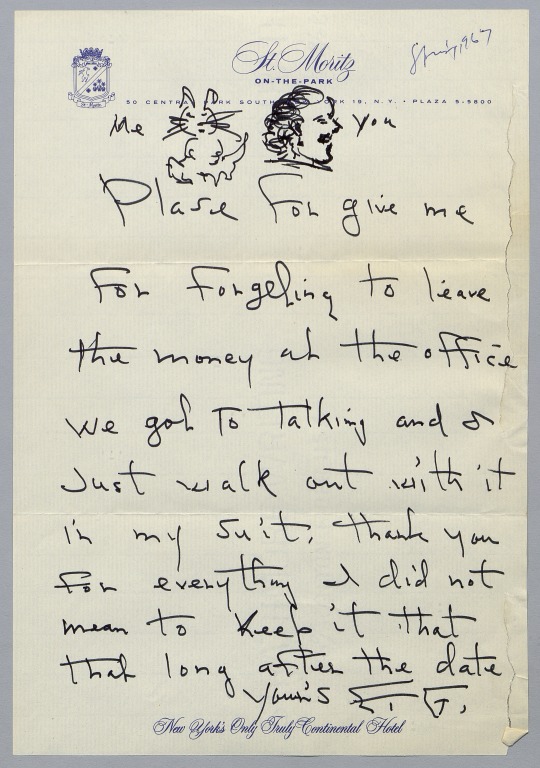
Image from Folder “Correspondence between Erroll Garner and Martha Glaser,” Erroll Garner Archive, 1942-2010, Box 3, Folder 5, Archives & Special Collections, University of Pittsburgh Library System.
Here, Garner and Glaser (referred to as “me” and “you,” respectively) are brought to proximity through their correlation with two hand-drawn characters: a rabbit with exaggerated whiskers and a stern human face looking away from the furry creature. We may be at a loss as to how or why Garner and Glaser might impressionistically resemble a fluff ball and a formidable face, but there must be some overriding logic—to Garner, at least—that somehow stabilized the two sets of characters. Garner is to Glaser as the rabbit is to the female portrait. Through symbolic consistency, Garner and Glaser are united as cartoon figures that appear in the top margins of his apology letter.
Garner the Rabbit reappears in a follow-up note—though without the company of Glaser’s cartooned face—where Garner apologizes again for his forgetfulness. In a different letter from 1967, he represented himself as yet another non-human creature, this time a cat. With a characteristic “me-wow,” the feline sits at the bottom of the letter and wishes a speedy recovery to Glaser, who appeared to be sick.
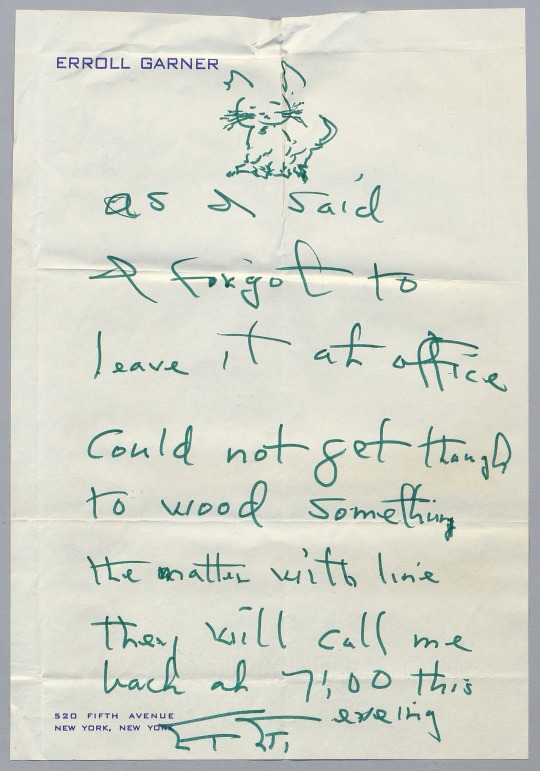
Image from folder “Correspondence between Erroll Garner and Martha Glaser,” Erroll Garner Archive, 1942-2010, Box 3, Folder 5, Archives & Special Collections, University of Pittsburgh Library System.
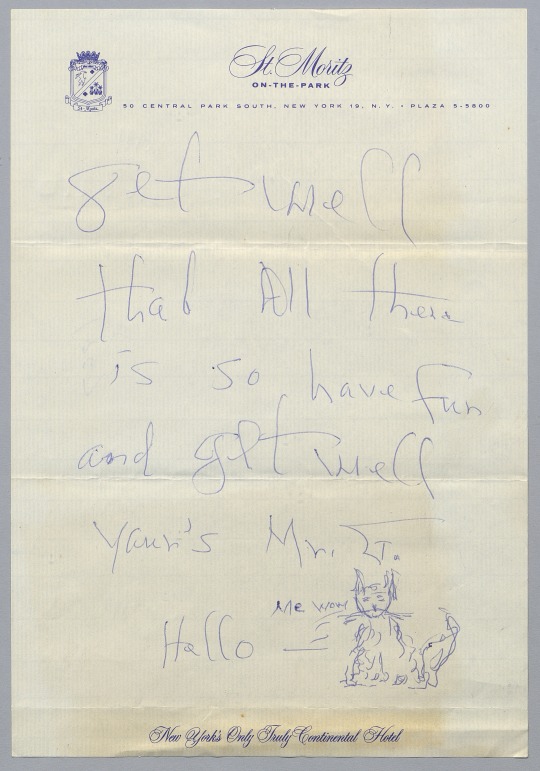
Image from folder “Correspondence between Erroll Garner and Martha Glaser,” Erroll Garner Archive, 1942-2010, Box 3, Folder 5, Archives & Special Collections, University of Pittsburgh Library System.
It is apparent that Glaser had received and read these letters. Scrupulous manager that she was, Glaser dated these letters in her flowing handwriting. But other than the fact that she had cared enough to keep them, we have no information as to how she might have reacted to Garner’s curious drawings. Her lack of reciprocity in the archive piques our interest: Did she approve of his analogy? Was she really the austere figure that made an expressionless face when Garner forgot to leave the money? Did she turn away, like the conspicuously dispassionate figure did, after seeing these sketches?
What appears to be a simple invocation of Garner and Glaser is more complex than it first seems. According to Alexander Galloway, the word “analogy” is derived from the prefix ana- (“at the rate of,” “by reason of,” or “in proportion to”) and the Greek word logos (“ratio,” “rationality,” “word”). Analogos means “in proportion with another ratio.” For Galloway, analogy is about creating an equation of comparable qualities, approximating the magnitude of one relationship to that of another. Seen in this light, analogy conjures two relationships and the things that constitute them. If it takes a party of two at the minimum to make up a relationship, then analogy necessarily invokes at least four entities by virtue of the two relationships it sets up. Garner’s analogy, for example, calls forth the musician–manager dyad, the animal–human counterpart, and the two sets of dynamics they represent. Analogy entails matchmaking, an operation that connects distant individuals to form sympathetic relationships.
It wouldn’t be too far-off, I think, to consider analogizing a deeply intimate gesture—an expression of voraciousness, even—for analogy devours a cornucopia of things and produces new relationships. Vilém Flusser wrote in Gestures, the moment of love is exactly the “complete absorption in the other without loss of the self;” it is the moment of “the tipping over into another, which makes ‘I’ and ‘you’ into ‘we’ […]” (51). Might analogy be similar to the way love creates bonds out of isolated conditions? Akin to Flusser’s definition of love, analogy integrates: it binds thoughts, transcends gaps, and redefines differences. Analogy performs promiscuous magic on lonely signs like “you,” “me,” rabbit, cat, and face, turning them into partners. Its capacity to conjoin different points of references into a network of meanings is what makes analogy such a potent tool to think with—and to inflict desire with.
Garner’s sketches were but the tip of the iceberg of how analogy operated for him and how we might come to understand the complex relationship between Garner and Glaser. In their correspondence, we see Garner recurrently employing analogy to frame his relation to Glaser, sometimes via seemingly innocuous cartoon drawings, other times involving the use of dissipated visual cues that transgress professional boundaries. The latter is seen, for instance, in a postcard depicting a rooster chasing after a hen in front of an old maid’s home, or in another where a newborn baby lasciviously attempts to grab a sexually depicted nurse, or in one showing a husband in a bedroom with his newlywed wife yelling at him for his female-figure tattoo.

Image from folder “Correspondence between Erroll Garner and Martha Glaser,” Erroll Garner Archive, 1942-2010, Box 3, Folder 4, Archives & Special Collections, University of Pittsburgh Library System.

Image from folder “Correspondence between Erroll Garner and Martha Glaser,” Erroll Garner Archive, 1942-2010, Box 3, Folder 4, Archives & Special Collections, University of Pittsburgh Library System.
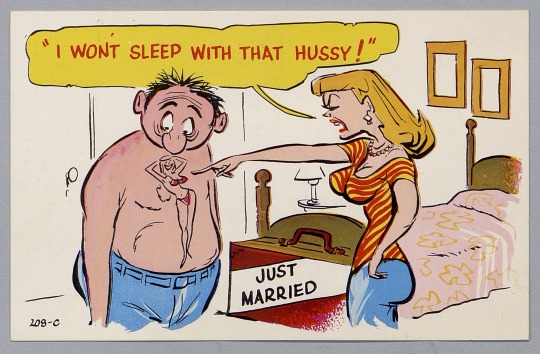
Image from folder “Correspondence between Erroll Garner and Martha Glaser,” Erroll Garner Archive, 1942-2010, Box 3, Folder 4, Archives & Special Collections, University of Pittsburgh Library System.
Garner wrote down commentaries to these images on the back of the postcards. On the “old maid” and rooster: “Are you glad you got me so you don’t have to be that way.” On the baby and the nurse: “Ours won’t be like that / he be cool / Ha Ha Ha.” On the tattooed husband: “I’ll have all mine taken off for you so there will be me and you and no one.” These postures indicate that at some point in time Garner had envisioned his relationship with Glaser through sexual analogies. These articulations expose the sharp edge of analogy, while also raising slippery questions about the nature of the relationship between Garner and Glaser.
What do these insinuations tell us? In the Erroll Garner Archive, there are very few materials surrounding the full nature of the types of relationships that may have existed between Garner and Glaser, which also may have changed at various points in time. Glaser, for one, did not leave any immediately traceable responses. Additionally, there was no postage stamped on these cards, which suggests that they might have been delivered personally or not been delivered at all. In lieu of a hard-and-fast conclusion, these messages require further contextualization before they can be understood in relation to the known history of Erroll Garner.
Given all the messiness that analogy seems to cause, it would have been more prudent, perhaps, to enact ways of visualizing a relationship through different means. But what if that relationship is inherently romantic? Would it be possible to articulate such a relationship in an un-analogized form? There is a fine line between analogy and love. What is love without a party of two, without phrases like “ma cherie,” “the very air I breathe,” “sweetheart,” “fly to me,” and “sweet rapture”? Love comes with a proportionate ratio and a trapping of significance. There is no love without analogy.
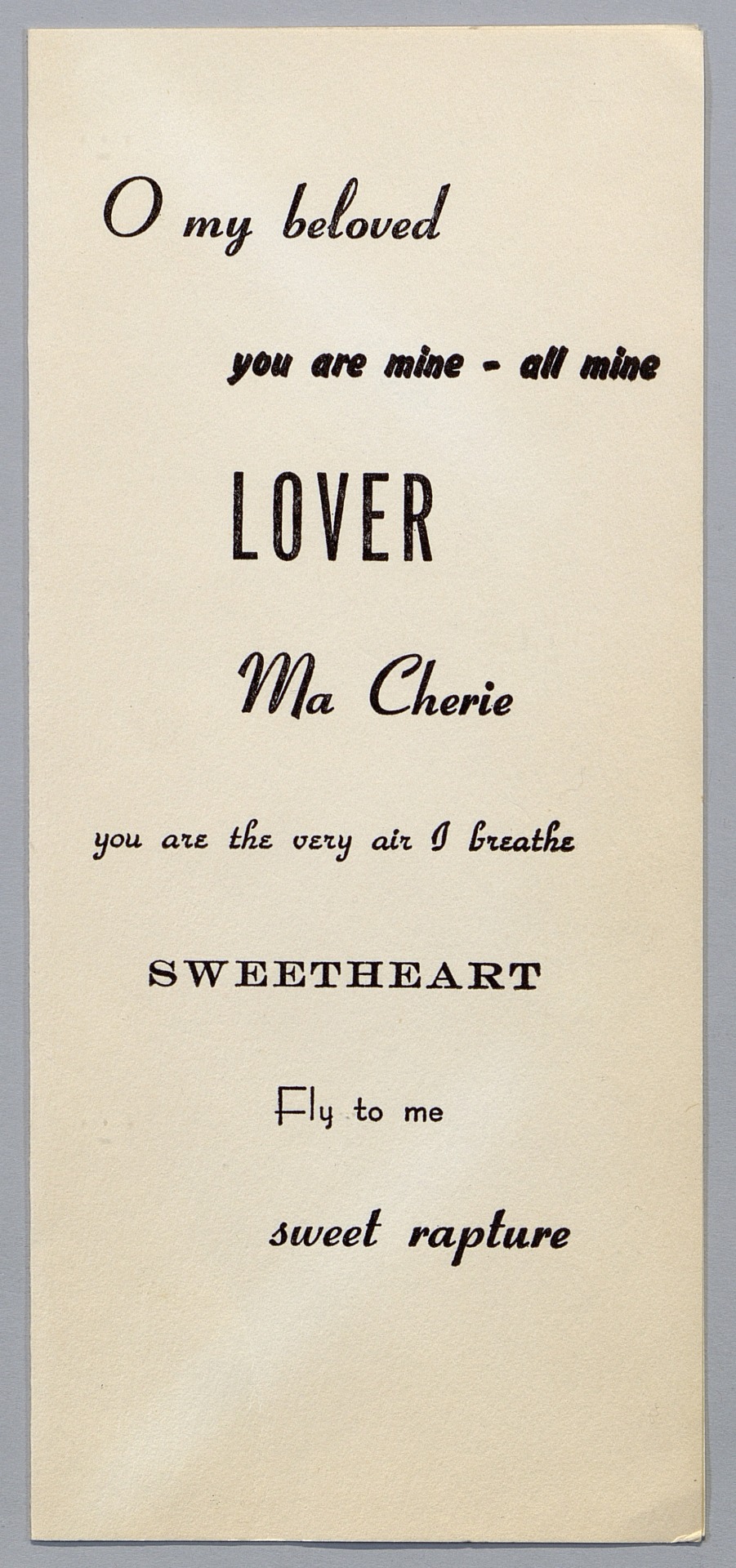
Image from folder “Correspondence between Erroll Garner and Martha Glaser,” Erroll Garner Archive, 1942-2010, Box 3, Folder 4, Archives & Special Collections, University of Pittsburgh Library System.
Works Cited
Alexander Galloway, “What Is the Analog,” last modified December 29, 2017 http://cultureandcommunication.org/galloway/what-is-the-analog
Erroll Garner Archive, 1942-2010, AIS.2015.09, Archives & Special Collections, University of Pittsburgh Library System.
Vilém Flusser, Gestures, trans. Nancy Ann Roth (Minneapolis: University of Minnesota Press, 2014), 51.
3 notes
·
View notes
Text
BUFFALO JUMPS FOR JOE: Kleinmans Music Hall, Winifred Easton Corey, and Joe Rico
This post was written by Deanna Witkowski, pianist-composer, graduate student in Jazz Studies at the University of Pittsburgh, and author of Mary Lou Williams: Music for the Soul (Liturgical Press, August 2021).
Late 1958 through early 1959 was a busy performance season for Erroll Garner. After being signed in May of 1958 as the sole jazz artist among the client roster of impresario Sol Hurok, Garner performed in major concert halls including the Cleveland Music Hall, Orchestra Hall in Chicago, Massey Hall in Toronto, and Symphony Hall in Boston. In the late summer of 1959, Garner toured for more than six weeks in Europe, and on October 16, he played a sold-out concert at Carnegie Hall. In between these major tours, Garner had several stateside concert dates that were booked by his manager, Martha Glaser, and not by Hurok. One of these dates was in a city not often included in the annals of jazz history: Buffalo, New York.
Sometimes short business letters open windows onto regional jazz histories. This was my experience in examining several January and February 1959 letters from Glaser sent in regards to Garner’s upcoming April 25 concert at Buffalo’s Kleinhans Music Hall. Rather than draw conclusions or attempt to paint a picture of exactly what occurred behind the scenes leading up to that performance, this post will examine my research methodology and how such documents reveal the importance of regional jazz promoters, performance venues, and management, specifically in relation to Garner and to the city of Buffalo.
Beginning Glances
Below is the first archival note I examined, written on January 9 to a Miss Winifred Corey at Kleinhans.
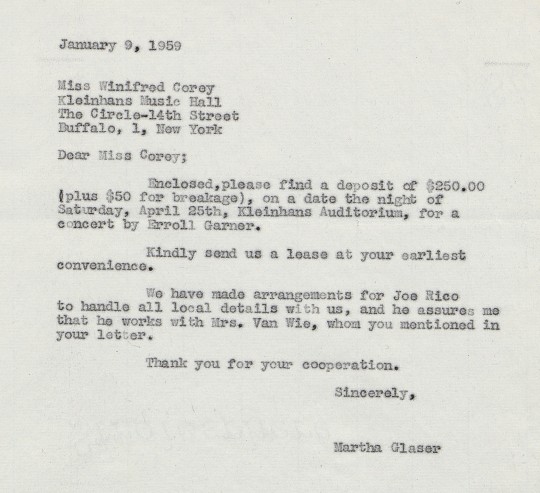
Image from folder “Martha Glaser Outgoing Correspondence,” Erroll Garner Archive, 1942-2010, Box 68, Folder 10, Archives & Special Collections, University of Pittsburgh Library System.
Each time I read a document in the archive, I jot down any specific names or subjects that are mentioned. For this first note, I wrote down the following:
Kleinhans Music Hall
Winifred Corey
Joe Rico
Mrs. Van Wie
$250 deposit
local details
Turning the digital archival page, I found a series of letters that Glaser sent with alarming frequency to Joe Rico on February 3, 4, and 5. My subject notes included:
Sol Hurok
lease
Wurlitzer Music Store
publicity
ticket pricing
“heralds and cards”
scheduling a date for the concert announcement
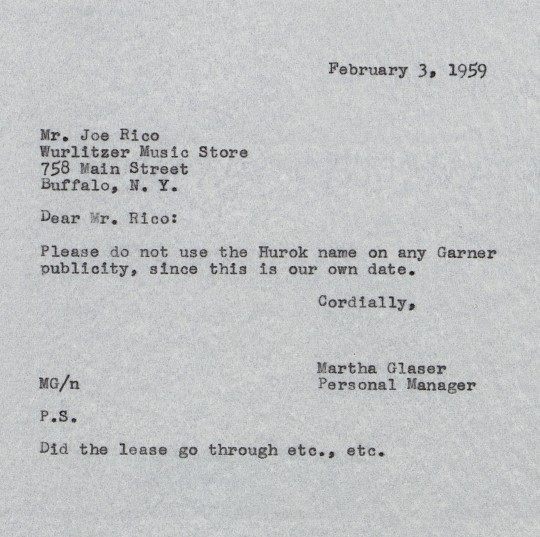
Image from folder “Martha Glaser Outgoing Correspondence,” Erroll Garner Archive, 1942-2010, Box 68, Folder 10, Archives & Special Collections, University of Pittsburgh Library System.
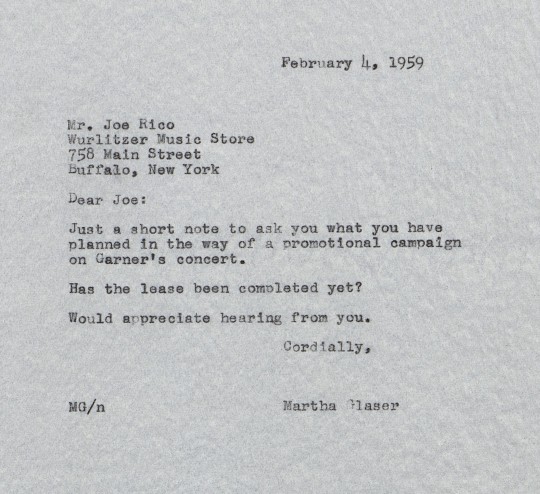
Image from folder “Martha Glaser Outgoing Correspondence,” Erroll Garner Archive, 1942-2010, Box 68, Folder 10, Archives & Special Collections, University of Pittsburgh Library System.
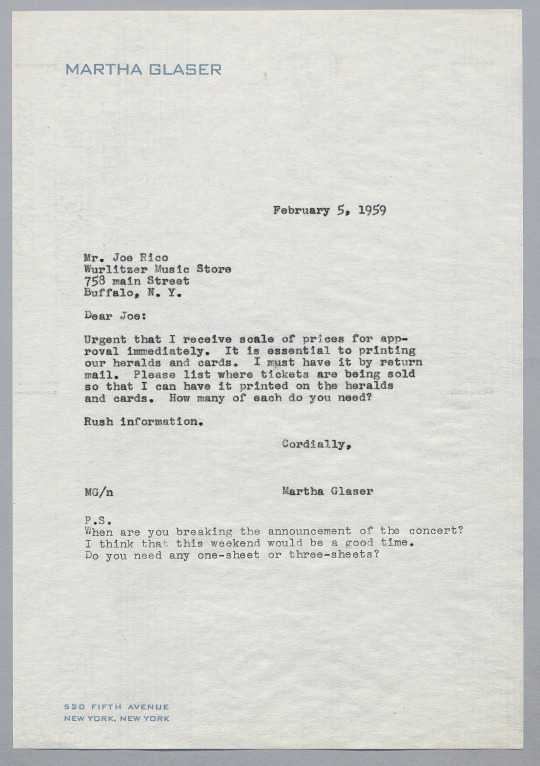
Image from folder “Martha Glaser Outgoing Correspondence,” Erroll Garner Archive, 1942-2010, Box 68, Folder 10, Archives & Special Collections, University of Pittsburgh Library System.
Putting these lists together, I did some cursory digging to see what I could find on the Buffalo-centric subjects: Corey, Rico, Van Wie, Kleinhans, and the Wurlitzer Music Store. I also notated secondary possible themes such as tour itineraries (why was Glaser making all of the arrangements for this concert date when Hurok had been booking Garner for the past year?) and the ways in which Glaser’s work was dependent on regional arts players.
While I have not yet found information on Mrs. Van Wie and the Wurlitzer Music Store, here is some of the rich history I found on the other subjects of our story.
A Major Jazz Destination
[1960 Buffalo Jazz Festival] producers [Ed] Sarkesian and [George] Wein regard Buffalo as one of the top five jazz markets in the country, based on the record of successful shows staged at Kleinhans Music Hall and local theaters.
–Buffalo Courier-Express, July 24, 1960 (Cichon January 14, 2018, Buffalo in the 60s: Satchmo, Basie, Duke, Brubeck headline Buffalo Jazz festival)
I fully admit as a former western New Yorker that I never knew about Buffalo’s history as a major destination for jazz artists. This history is due in large part to Kleinhans Music Hall. Having an acoustically excellent performance hall was a longtime dream of Edward L. and Mary Seaton Kleinhans. Edward was the founder of the Kleinhans Clothing Store; Mary was a classical pianist; and together, the couple avidly collected art and made frequent travels abroad. In 1934, Edward and Mary died within three months of each other. Both had expressed in their wills their desire to leave their money to the city of Buffalo. Five years later, construction began on a music hall named in their honor and paid for with their money (as well as with additional funds from the Public Works Administration). On October 12, 1940, the Buffalo Philharmonic Orchestra performed at the dedication of the hall. The dedication booklet from that evening, including extensive program notes, history, and photos is available online. The booklet also includes an article on the hall’s management by Kleinhans Music Hall director— and the recipient of Glaser’s January 1959 letter—Winifred Easton Corey. Corey describes the 2800 seat main auditorium as well as the 800 seat Mary Seaton Kleinhans Music Room (pianist Christian Sands performed a Garner tribute in this latter room on February 2, 2020). The hall was designated a National Historic Landmark in 1989.
Searching for Corey in the Garner archive, I found this response from Corey to Glaser written six days after Glaser’s deposit:
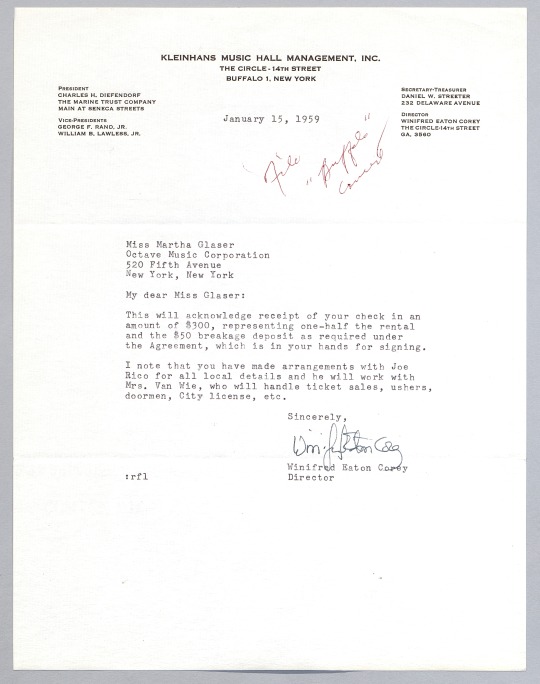
Image from folder “Martha Glaser Incoming Correspondence,” Erroll Garner Archive, 1942-2010, Box 68, Folder 9, Archives & Special Collections, University of Pittsburgh Library System.
The names of Joe Rico and Mrs. Van Wie surface again in Corey’s note. While I have not yet found information on Van Wie, who, in Corey’s words, handled “ticket sales, ushers, doormen, City license, etc,” Rico’s name opened up a treasure trove of Buffalo’s—and Miami’s—jazz history.
A Veteran Jazz Disc Jockey
Glaser’s frequent notes to Joe Rico in early February 1959, as well later notes from February 27 and March 3 reveal the urgency with which she needed to receive publicity information.
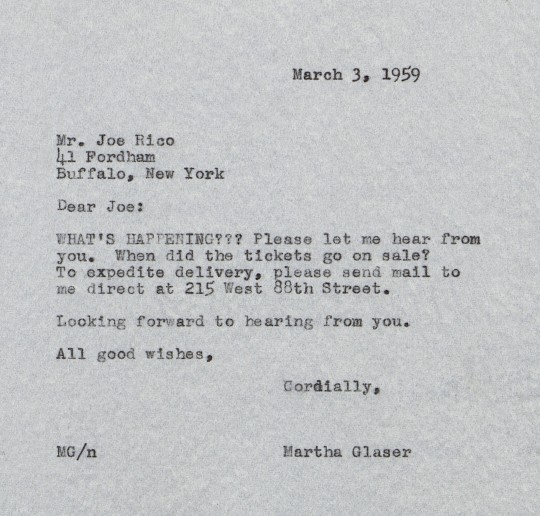
Image from folder “Martha Glaser Outgoing Correspondence,” Erroll Garner Archive, 1942-2010, Box 68, Folder 10, Archives & Special Collections, University of Pittsburgh Library System.
It appears that Glaser had not received information as to the date when the tickets went on sale. In her February 5 letter, she expressed that she immediately needed ticket pricing to create a publicity material print run of “heralds and cards.” While we do not know what information Rico sent, we do know that two-and-a-half years earlier, on November 7, 1958, Glaser included Rico’s name as part of a short list of disc jockeys for Garner to call to thank for airplay of his gold-certified album Concert by the Sea.
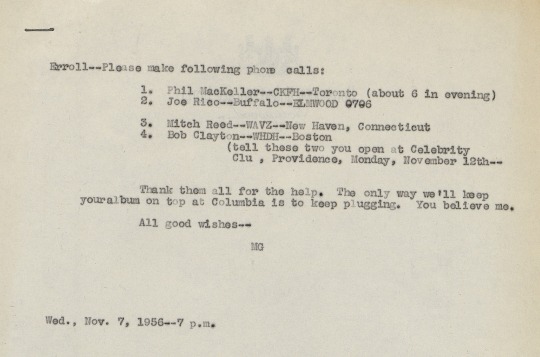
Image from folder “Correspondence between Erroll Garner and Martha Glaser,” Erroll Garner Archive, 1942-2010, Box 3, Folder 2, Archives & Special Collections, University of Pittsburgh Library System.
Whether Rico had made the first move to assist in getting Garner to Kleinhans or Glaser was the initial person to reach out, it is clear that Rico was a major force in jazz in Buffalo. In over a fifty-year broadcasting career at WEBR in Buffalo and WBUS in Miami, Rico was known by major jazz artists, some of whom composed pieces in his honor. One of these was Stan Kenton, who released “Jump for Joe” on Capitol Records in 1951:
youtube
(Above) Audio of “Jump for Joe” by Stan Kenton, recorded in 1951.
In addition to Garner’s 1959 concert, Rico hosted performances by Duke Ellington and Charlie Parker at Kleinhans and assisted Newport Jazz Festival founder George Wein in creating the Buffalo Jazz Festival in 1960. Downbeat named Rico the 1954 disc jockey of the year. Relocating to Miami in the 1970s, Rico served as general manager for WBUS and opened a jazz club, “Rico’s Room,” in the Airliner Hotel. The video below shows footage of Rico as well as one of the groups that performed at the club, Maynard Ferguson’s band (the video is also significant for its interview with multi-instrumentalist Ira Sullivan, who, like Rico, passed in 2020).
youtube
(Above) This excerpt features jazz DJ Joe Rico in his Miami club, Rico’s Room. This video and audio is copyrighted/owned by the Lynn and Louis Wolfson II Florida Moving Image Archives.
While this initial research has only scratched the surface of the import of Buffalo as a jazz center in the 1950s and 1960s as well as the interdependence between artist management and local promoters, it shows the importance of examining cities outside of New York, Chicago, New Orleans, and St. Louis in jazz historiography. As a self-managed pianist-composer myself for over twenty years, my on-the-ground touring and booking work has shown me that there is always a Winifred Corey, Joe Rico, or a Mrs. Van Wie who are part and parcel of making my work a success. This blog post is dedicated to each community member who makes the working lives of artists possible.
Bibliography
Erroll Garner Archive, 1942-2010, AIS.2015.09, Archives & Special Collections, University of Pittsburgh Library System.
Cichon, Steve. “Buffalo in the 60s: Satchmo, Basie, Duke, Brubeck headline Buffalo Jazz festival,” Buffalo Stories (blog), January 14, 2018, http://blog.buffalostories.com/buffalo-in-the-60s-satchmo-basie-duke-brubeck-headline-buffalo-jazz-festival/.
the78prof. “1951 Stan Kenton Jump for Joe.” YouTube video, 3:02. May 19, 2019. https://www.youtube.com/watch?v=tSHbnF6dX5w
wolfsonarchives. “70s Jazz in Miami.” YouTube video, 3:50. April 26, 2013. https://www.youtube.com/watch?app=desktop&v=lrFaPmgCNZI&feature=youtu.be
1 note
·
View note
Text
T.G. Masaryk’s Notebook
This post was written by Gabe Slon, a recipient of an Archival Scholar Research Award for the 2021 Spring Semester.
How often do we find ourselves wishing to pick someone’s brain? Reading someone’s handwritten notes is about as close as we might come to that, especially if said someone was a Czech statesman who lived a century ago.
Tomas G. Masaryk was a Czech diplomat, historian, and nationalist who spent 1914-1918 in exile from Bohemia, lobbying the Allied powers to grant Czechoslovak statehood at the conclusion of World War I (Masaryk 1973, 10-11). An interesting object I found in my research was Masaryk’s preliminary outline and notes for The New Europe (The Slav Standpoint).

Cover of Masaryk’s outline and notes for The New Europe (The Slav Standpoint). From Box 1, Folder 27, Thomas G. Masaryk Papers, 1918-1938, SC.1983.01, Archives & Special Collections, University of Pittsburgh Library System.
The outline and notes themselves were intended for Masaryk’s eyes. These notes were written down by Masaryk on a journey from Russia, across Siberia, across the Pacific and to the West, where the first English edition of this book would eventually be published in London in 1918 (Ibid, 8). In the introduction to The New Europe (The Slav Standpoint), Masaryk explains that he needed to create something “to make clear to our [Czech and Slovak] soldiers the fundamental problems of the war”, and so the book was originally written to expound these fundamental problems first to Czech and Slovak soldiers, and a year later it was revised and written in English to present the same fundamental problems to the “Anglo-Saxon public” (Ibid, 23).
In the handwritten notes preserved in the Thomas G. Masaryk Papers, Masaryk creates his logical framework for The New Europe (The Slav Standpoint). His handwritten notes tell us much about his thinking processes. On page 6 (page 9 of digitized document), for example, he defines a few important terms for himself:
Nation synonymous people… Nationality: modern principle; the moral and political foundation of it… Peace: terms of a democratic [undertaking]…(Masaryk 1918, 6)
In the top right corner of this page below lie the words “The right of self-determination of nations”. From looking at the notes on page 6 (page 9 of digitized document) alone, we get a sense of Masaryk’s guiding ideals (e.g., peace as a democratic undertaking, rather than a dictate from the victors), but also of Masaryk’s influences, namely Woodrow Wilson and his celebrated 14 points, among them being the right to self-determination. This is consistent with much of Masaryk’s work and diplomacy in this time, which was markedly influenced by Wilson’s 14 points.

Excerpt of list of countries and terms included in the outline, with “Right of self-determination of nations” in top right, page 6 (page 9 of digitized document). From Box 1, Folder 27, Thomas G. Masaryk Papers, 1918-1938, SC.1983.01, Archives & Special Collections, University of Pittsburgh Library System.
It is also worth noting that these notes were made in absence of any literature: as Masaryk was journeying from Moscow to the West (via the East), he wrote “without being able to consult the vast literature on the subject” (Masaryk 1973, 23).
These are thus Masaryk’s thoughts in isolation, written down to help him understand and clarify his own, existing understandings of the war and Europe as it stood. This being the case, it is even more remarkable that throughout this outline he is able to list (exhaustively) every country and nation in Europe, as well as many notable leaders from Germany, Austria-Hungary, and other such powers during the war. Masaryk compiles these names, places, and ideas in alphabetical order—his entry for “Peace” appears underneath “Norway” and above “Pangermanism” (below).

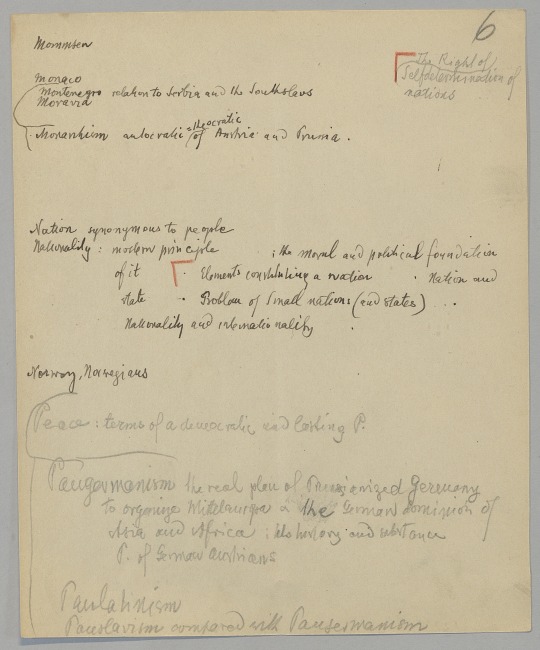
Full picture of part of Masaryk’s list of countries and terms in his outline for The New Europe (The Slav Standpoint), page 5-6 (page 8-9 of digitized document) . From Box 1, Folder 27, Thomas G. Masaryk Papers, 1918-1938, SC.1983.01, Archives & Special Collections, University of Pittsburgh Library System.
Citations:
Masaryk, T. G. The New Europe (the Slav Standpoint). (Lewisburg PA: Bucknell University Press), 1973.
Thomas G. Masaryk Papers, 1918-1938, SC.1983.01, Archives & Special Collections, University of Pittsburgh Library System.
3 notes
·
View notes
Text
Detroit’s Marxist Black Auto Workers
This post was written by Liam Sims, a recipient of an Archival Scholar Research Award for the 2021 Spring Semester.
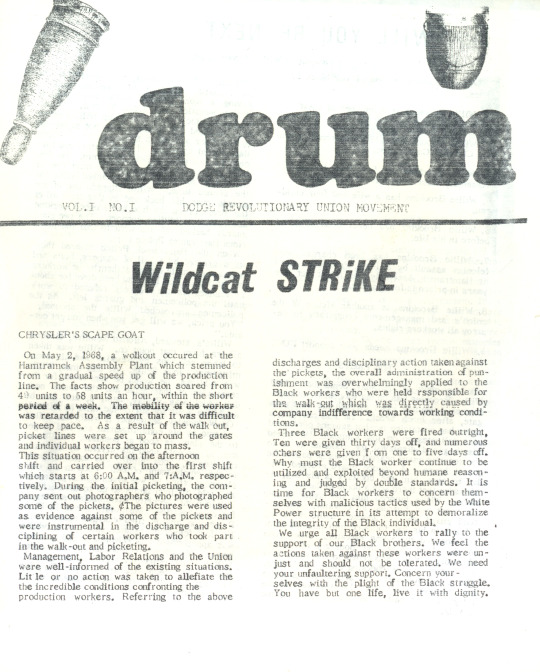
Images from “Drum Wildcat Strike”, Box 1, Folder 97, American Left Ephemera Collection, 1875-2015, AIS.2007.11, Archives & Special Collections, University of Pittsburgh Library System.
Detroit, Michigan is perhaps best known as the auto capital of the United States, home to the principal production plants of the mythical “Big Three”: General Motors, Chrysler, and Ford. While the auto industry promised a path to the middle class for some, it also embodied institutional racism and ruthless worker oppression for many of its Black workers. In 1968, some 60-70 percent of the workers at Chrysler Corporation’s Dodge Main assembly plant were Black, also relegated to the lowest paying, most physically demanding, and most dangerous positions of the plant compared to their white supervisors (Glaberman 1969, 8-9). In May of 1968, Black workers at the Dodge Main plant formed the Dodge Revolutionary Union Movement (DRUM), a grassroots organization which advocated for workers’ rights in the face of rampant discrimination. To promote the movement, DRUM created a publication which was distributed by hand at the plant and in nearby communities to support efforts to strike, elect representatives, and instill revolutionary social change in Detroit’s auto industry and beyond. Seen here is the first edition of DRUM’s publication, detailing the unwarranted dismissal of Black worker Willie Brookins out of prejudice. While the United Auto Workers (UAW) union was meant to protect all auto workers, the UAW often ignored cases like Mr. Brookins, incentivizing the creation of a group like DRUM to champion the rights of non-white workers as well. The title of this edition is “Wildcat Strike”, referring to one of a series of strikes DRUM organized without the UAW’s approval. By stopping the production line, Dodge lost an immense amount of revenue, forcing management to address DRUM’s demands. DRUM’s publication subverts the notion that national unions in the United States were not susceptible to racial bias and discrimination. In addition, DRUM helped to expose the collaboration between the UAW and auto industry management which lead to crackdowns on Black workers who demanded equality. In examining labor relations, it should be clear that Black workers have and continue to be treated differently, and often worse, than their non-Black peers. In different conditions, there are different needs. Despite all the plant workers sharing the same basic class interests, the UAW and management utilized racial divisions to ensure white workers would ignore or even demonize their Black counterparts in DRUM, for fear of losing what little autonomy they had.

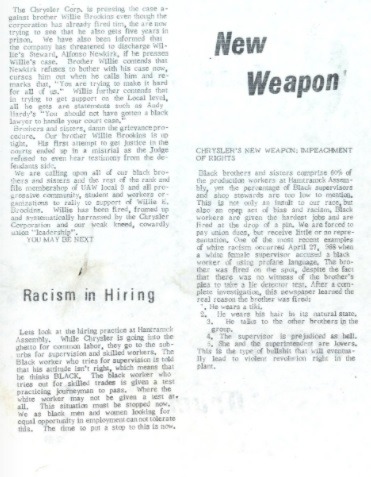
Images from “Drum Wildcat Strike”, Box 1, Folder 97, American Left Ephemera Collection, 1875-2015, AIS.2007.11, Archives & Special Collections, University of Pittsburgh Library System.
At first glance, the amateur quality of the publication is evident in the frequent typographic errors, mistakes in formatting, the quality of the print and paper, and its unabashed use of profanity. These elements are also the publication’s strength. It demonstrates DRUM’s urgency in its brevity, rudimentary visuals, and its use of blunt, everyday language to promote their grassroots campaign. Ephemera usually consists of printed materials like this publication, meant for immediate use with no concern given for preservation, meaning many of such items are cheaply produced and fragile. In the case of DRUM’s publication, this meant it was possible for the organization to distribute the pamphlets easily, inexpensively, and independently to auto workers and their families on a large scale. The evolution of DRUM’s ideology becomes apparent in this series of publications, beginning first as a movement addressing specific grievances in a single Dodge auto plant to the application of a Marxist-Leninist framework to free racially oppressed workers nationally. Ending with “this is the type of bullsh*t that will eventually lead to violent revolution right in the plant”, it is clear that DRUM was driven by necessity to enact its own change.

Bibliography
American Left Ephemera Collection, 1875-2015, AIS.2007.11, Archives & Special Collections, University of Pittsburgh Library System.
Glaberman, Martin. “The Dodge Revolutionary Union Movement.” International Socialism, 1, no. 36 (1969): 8–9. https://www.marxists.org/archive/glaberman/1969/04/drum.htm.
2 notes
·
View notes
Text
Review of Historical Medical Documents to Examine Gender Bias in the Biomedical Community
This post was written by Su Diler, a recipient of an Archival Scholar Research Award for the 2021 Spring Semester.
The Pittsburgh Academy of Medicine was an organization established by Pittsburgh area physicians in 1889 for “the promotion of the science and art of medicine,” as they were unsatisfied with the “atmosphere and depth of scientific inquiry” practiced by the Allegheny County Medical Society. To achieve their ends, the Academy would regularly meet to present noteworthy scientific papers that included, but were not limited to, original research, new treatment methods, informative presentations, and medical case studies. Years later, the University of Pittsburgh Library Systems maintained archives of the Academy’s technical paperwork and the scientific papers presented at meetings between 1914-1935 in the Guide to the Pittsburgh Academy of Medicine Records,1878-1972, which has been the source for the bulk of the information provided.
One of the very first papers in these archives is a research and case study conducted and presented by Dr. Moses Have Baker in 1918 titled, “Report of 30 cases of Lobar Pneumonia Caused by Type I Pneumococcus, Treated with Type I Antipneumococcus Serum.” In this paper, Dr. Have Baker discusses a case trial involving 30 participants with type I infection strain of lobar pneumonia who received antipneumococcus serum, which demonstrated a reduction in death rates of patients; however, he concludes that the disease course is not altered and serum administration poses great risk to patients that are not unquestionably diagnosed with Type I infection.

The above image is an excerpt from the scientific paper, “Report of 30 Cases of Lobar Pneumonia Caused by Type I Pneumococcus, Treated with Type I Antipneuomoccocus Serum,” written by Dr. Moses Have Baker to present at a scientific meeting to fellow physicians at the Pittsburgh Academy of Medicine on April 30, 1918. From Box 3, Folder 33, Pittsburgh Academy of Medicine Records, 1889-1972, AIS.2017.01, Archives & Special Collections, University of Pittsburgh Library System.
Upon closer examination of the details typed on this document, one of the more interesting reports is not the efficacy of the medical treatment, but rather the composition and comment on the research subjects. On the second page at the end of the second paragraph, Dr. Have Baker makes a point to mention that “[o]ne feature which made it easy was that the patients were all adult males, with very little fat and with good muscular development so that the veins were large and prominent.”
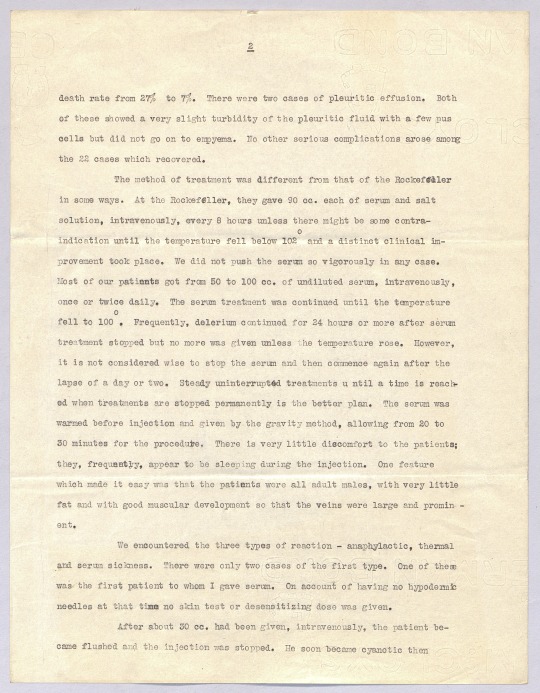
The above image is an excerpt from the scientific paper, “Report of 30 Cases of Lobar Pneumonia Caused by Type I Pneumococcus, Treated with Type I Antipneuomoccocus Serum,” written by Dr. Moses Have Baker to present at a scientific meeting to fellow physicians at the Pittsburgh Academy of Medicine on April 30, 1918. From Box 3, Folder 33, Pittsburgh Academy of Medicine Records, 1889-1972, AIS.2017.01, Archives & Special Collections, University of Pittsburgh Library System.
Although this piece of scientific literature was originally produced as a means to disseminate temporally relevant scientific findings, there is great benefit to be had in analyzing the sociocultural framework in which the scientific studies and medical culture of this time were built. Historically, women have been systematically left out of the medical field as both practitioners and patients. The roots of this exclusion may be elucidated by examining primary sources of historical scientific literature which may provide clues for today’s scholars regarding hidden but unequivocally held gender biases within the biomedical community at the time. For example, in analyzing Dr. Have Baker’s statement, veiled bias towards adult female research participants seems to be alluded to when he states that the adult male patients had “very little fat and with good muscular development” and thus made injections “easy.” The deliberate and formally typed up inclusion of this statement, placed alongside an explanation of the paper’s research methods–clearly intended for his Academy peers–suggests that it is part of a larger community sentiment that ease of conducting research takes precedence over sex and gender inclusionary research practice. Nevertheless, it must be noted that because this paper appears to be a personal or unofficial manuscript that Dr. Have Baker prepared–evidenced by the typos and crossed out words–present day scholars may never know what kind of discussion this paper inspired, particularly whether this statement was even a point of discussion or, if as hypothesized, it was an unquestioned sentiment and simply regarded as a commonplace protocol.
In examining such scientific papers archived in the Pittsburgh Academy of Medicine Records, it is my hope to uncover the underlying gender biases and beliefs that have been systematically incorporated into the medical community. Whether the apparent biases under examination from these papers have connections to the present day biomedical community and their practices is the topic of my Archival Scholars Research Awards’ research, and I hope to present a thorough report of my findings at the end of the research period!
Citation:
Dr. Moses Have Baker, "Report of 30 Cases of Lobar Pneumonia Caused by Type I Pneumococcus, Treated with Type I Antipneumococcus Serum," Box 3, Folder 33, Pittsburgh Academy of Medicine Records, 1889-1972, AIS.2017.01, Archives & Special Collections, University of Pittsburgh Library System.
#ASRA2021#ASRA#medical history#gender bias#biasinmedicine#allegheny county#PittsburghAcademyofMedicine
0 notes